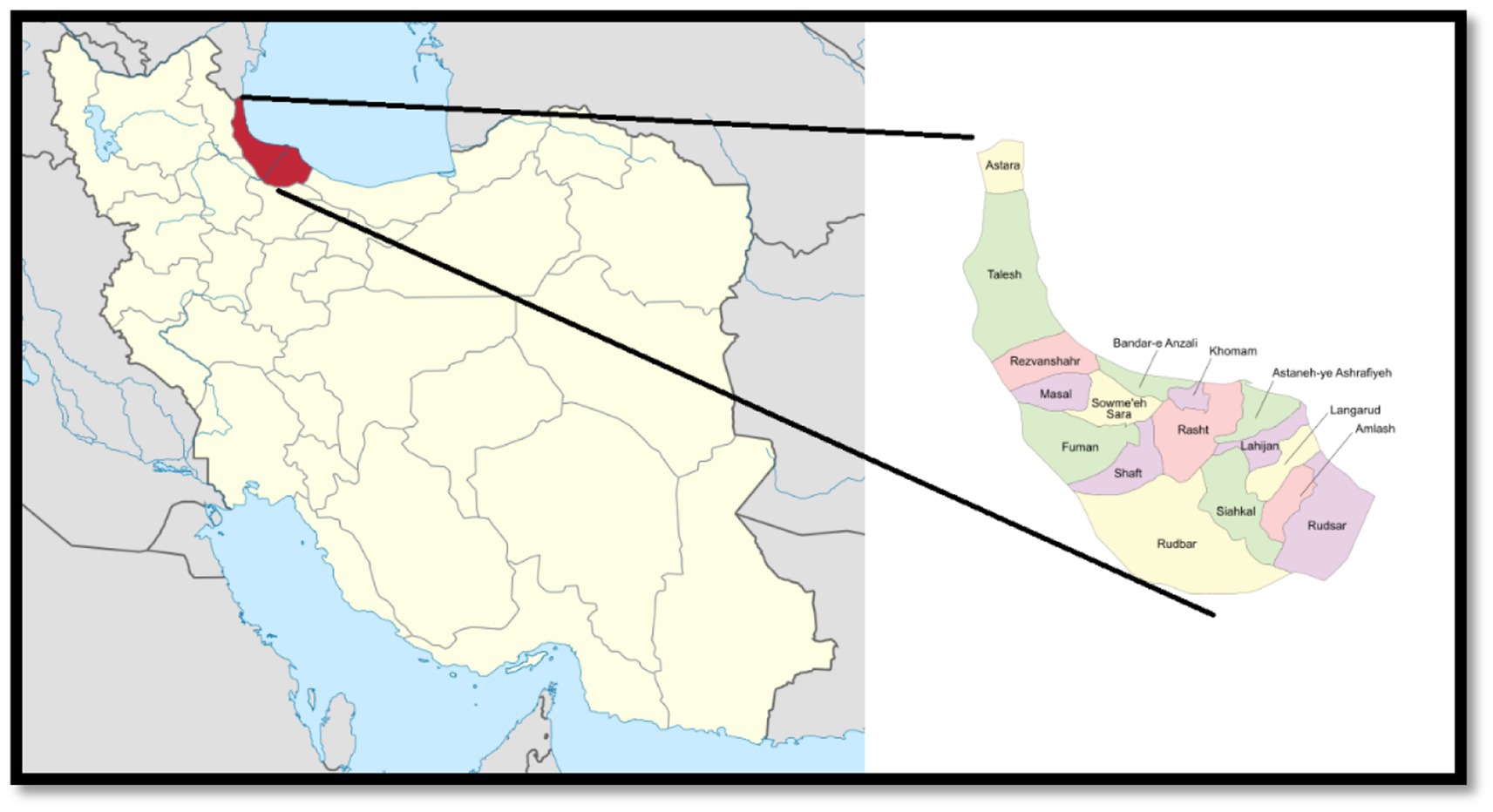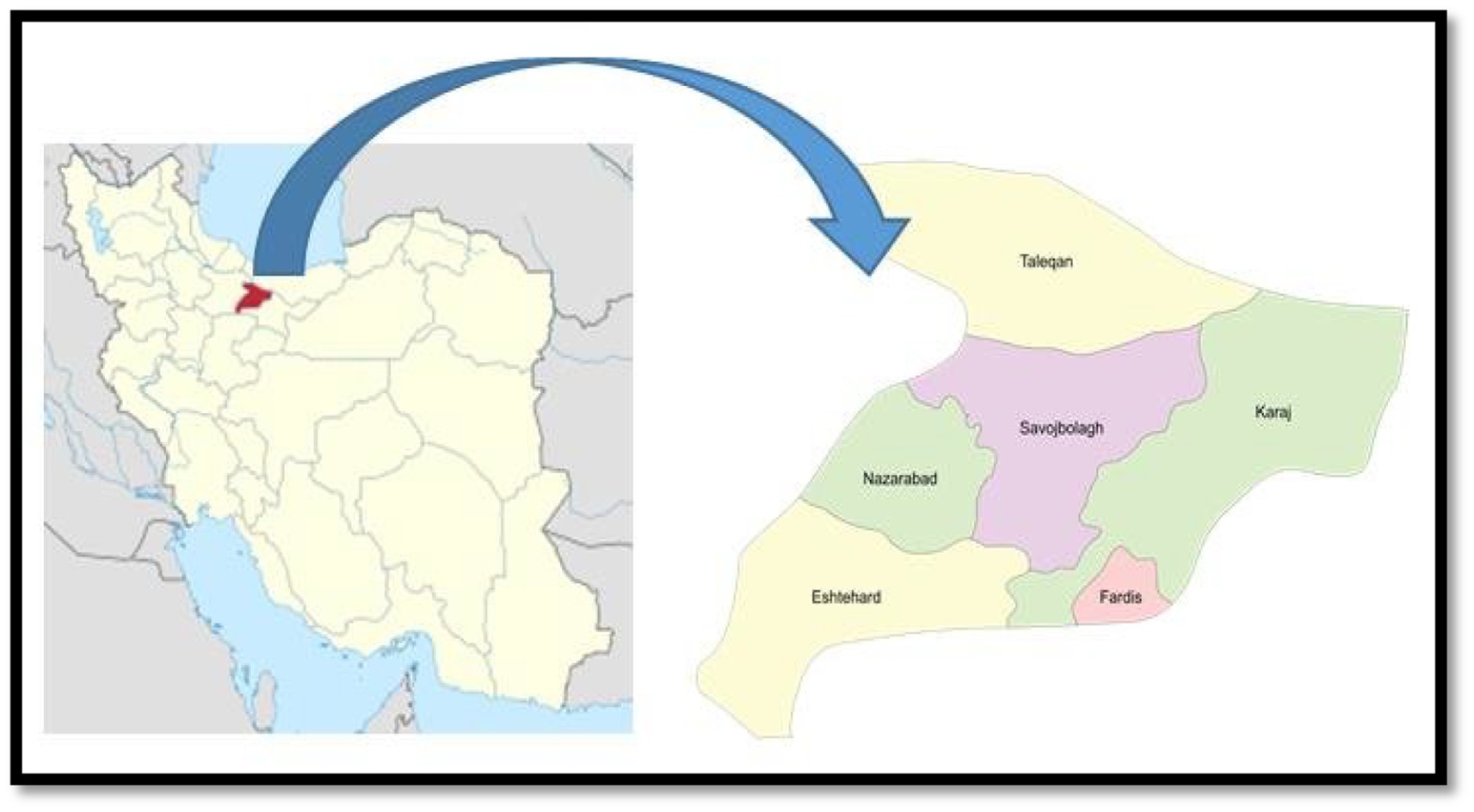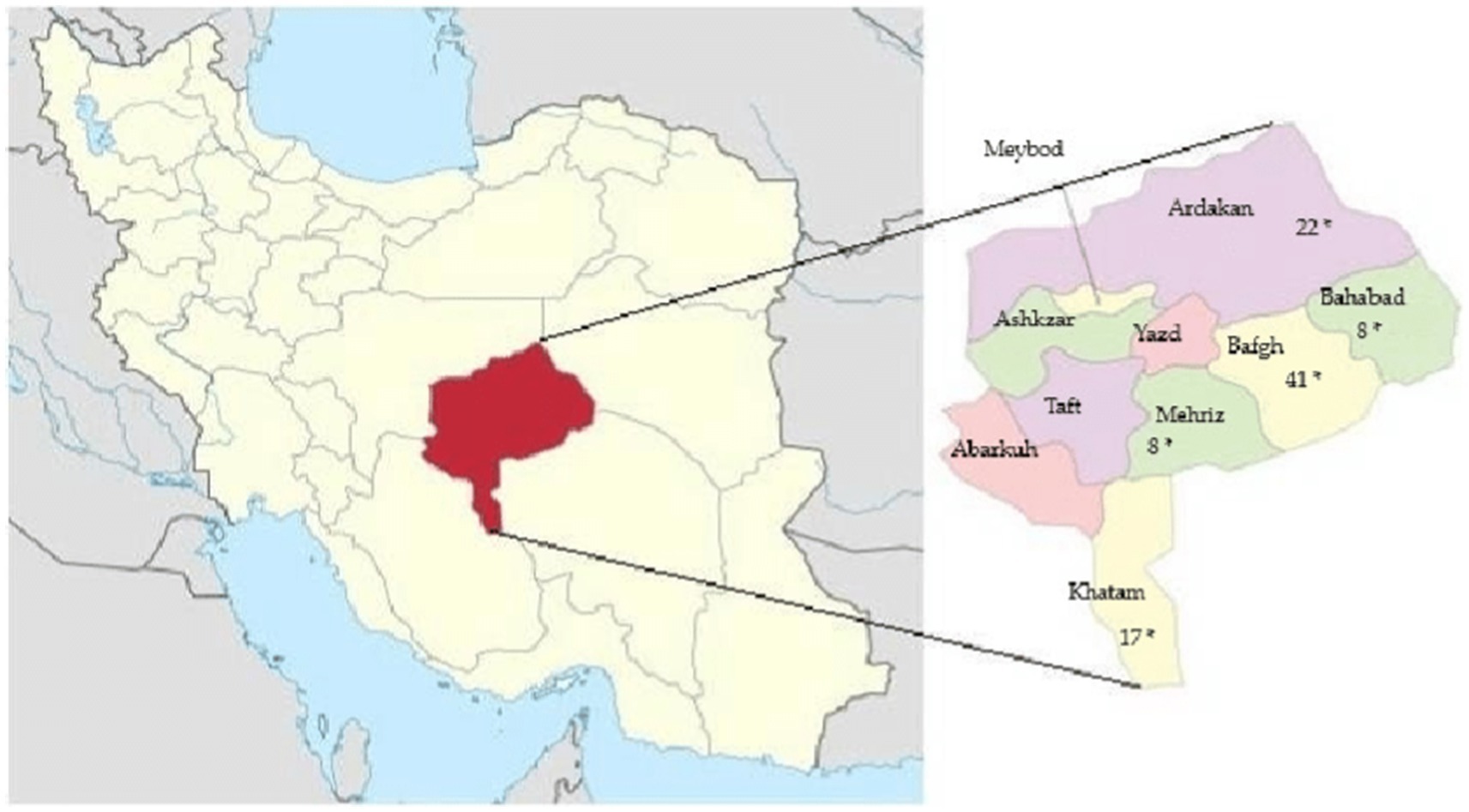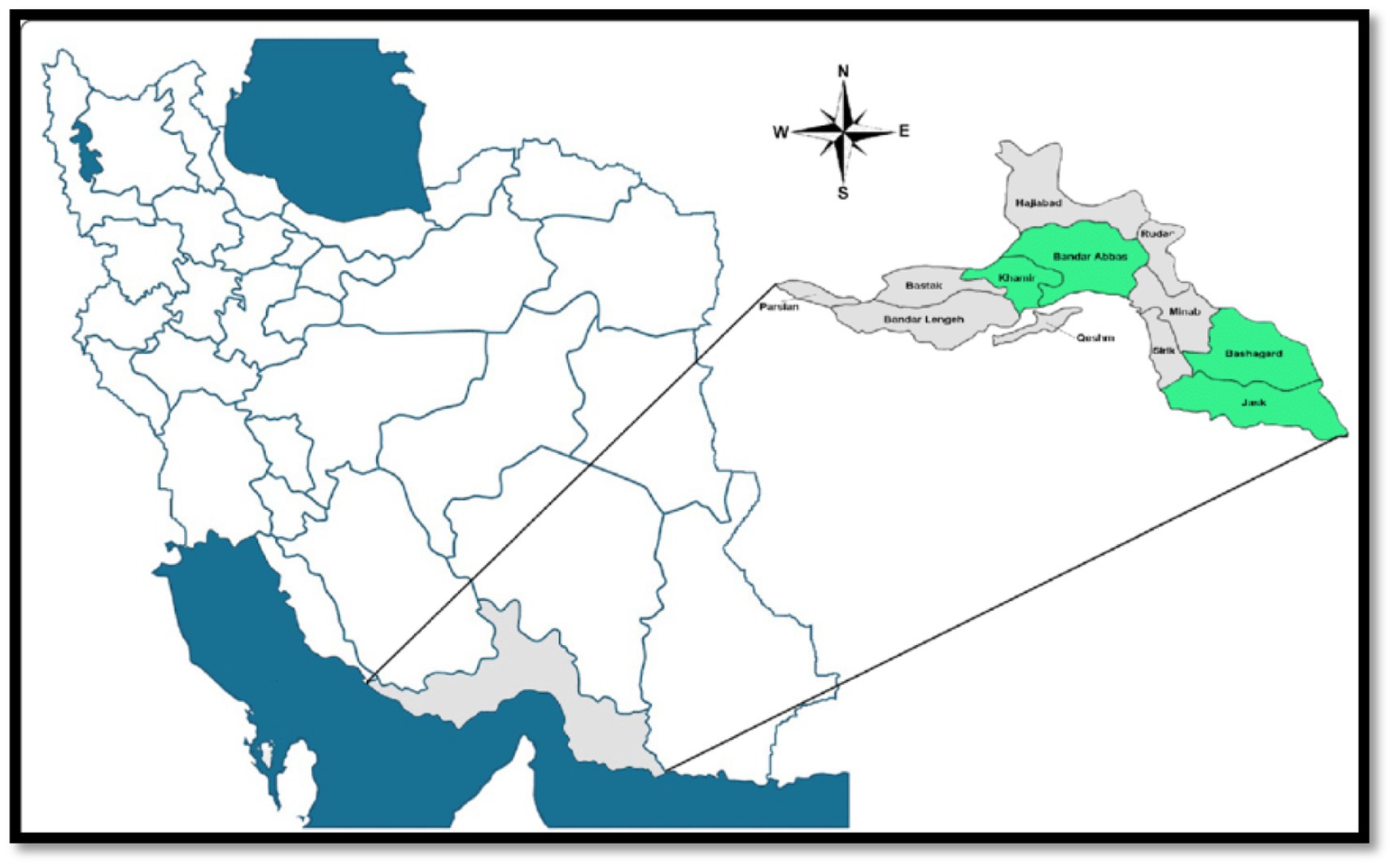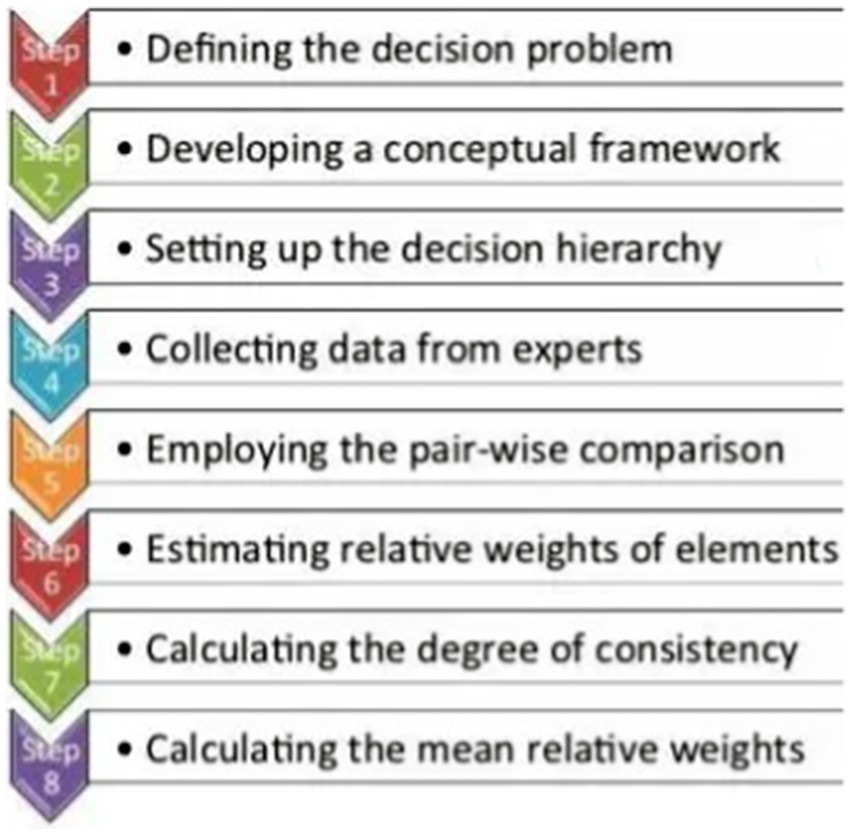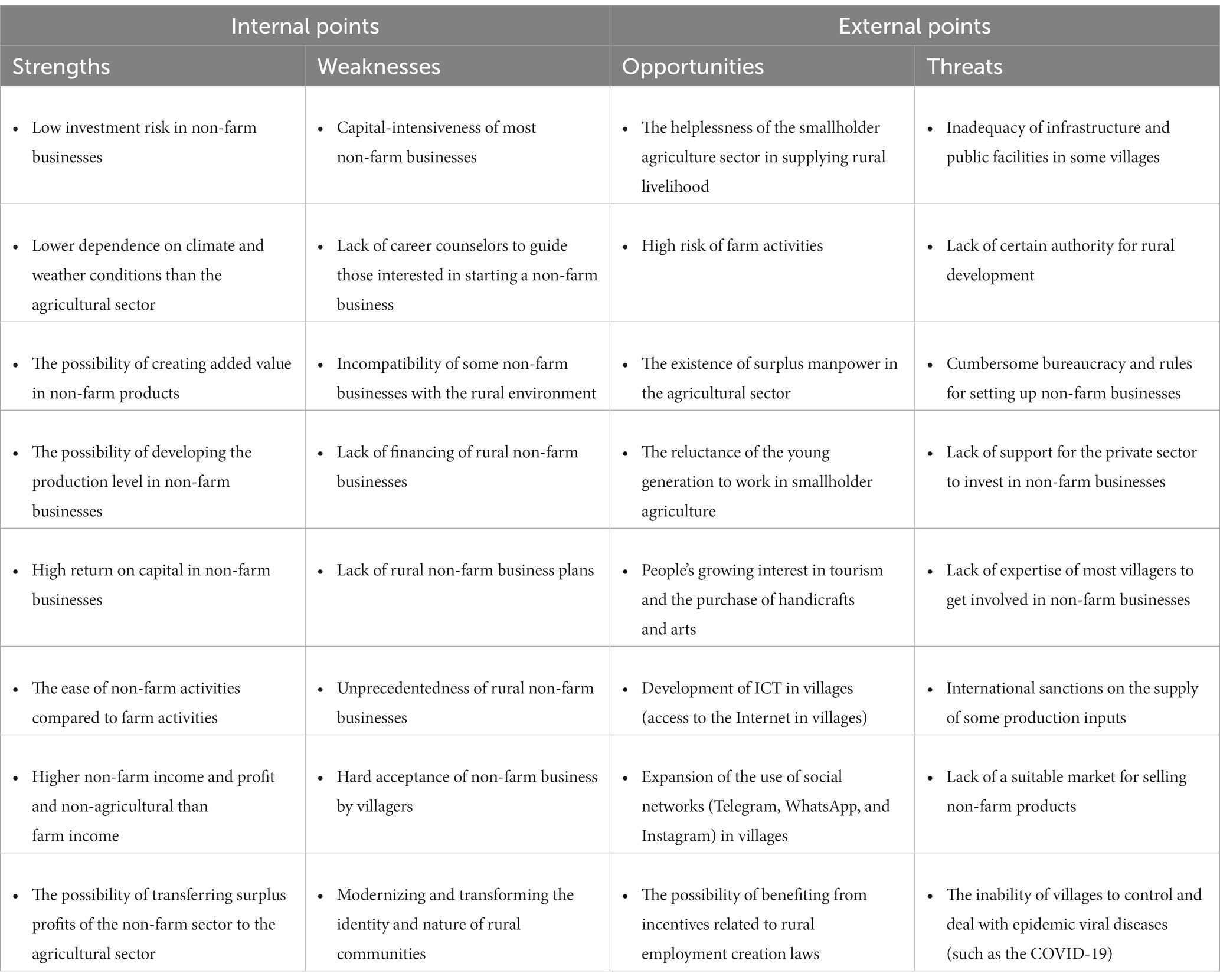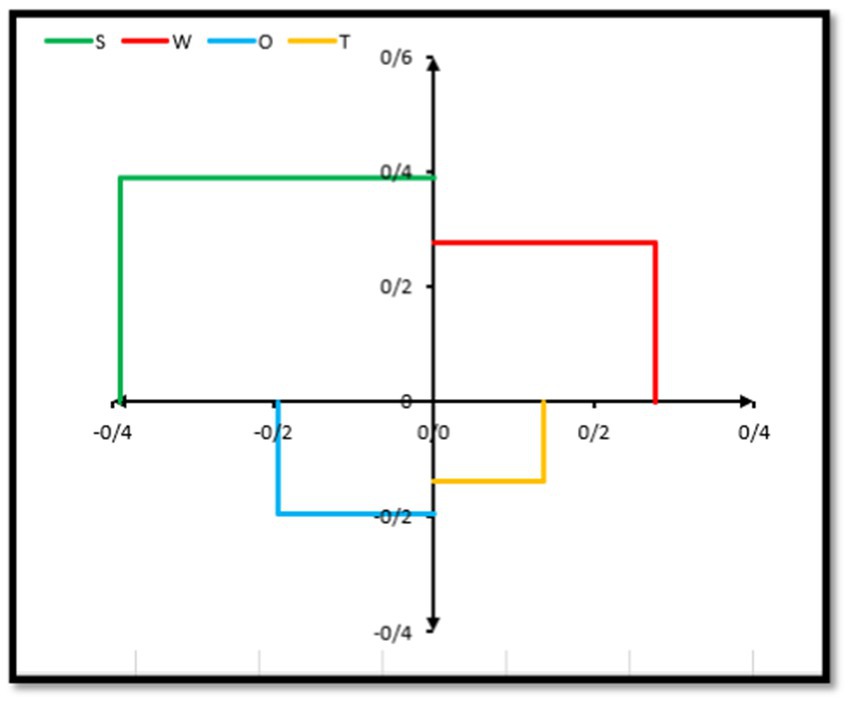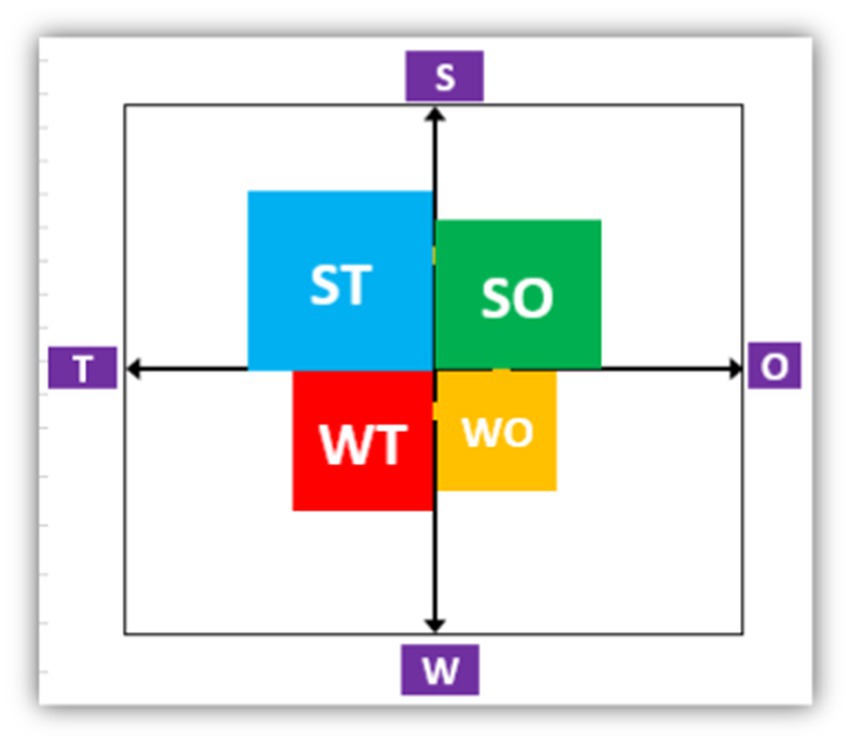- 1Department of Agricultural Extension and Education, Garmsar Branch, Islamic Azad University, Garmsar, Iran
- 2Department of Agricultural Extension and Education, College of Agriculture, Tarbiat Modares University (TMU), Tehran, Iran
- 3Imam Khomeini Higher Education Center, Agricultural Research, Education, and Extension Organization, Karaj, Iran
Non-farm activities are a means of livelihood stabilization and are regarded as a sustainable approach to bringing balance to the economic, social, cultural, and environmental dimensions of sustainable livelihood. The main purpose of this study was to develop strategies for stabilizing the livelihood of smallholder farmers through non-farm activities using a combined SWOT-AHP-TOWS model. The results of analyzing the strategic space for developing strategies for stabilizing the livelihood of smallholders through non-farm activities revealed that the strengths (0.391) were more than the weaknesses (0.276) in the internal space and that the opportunities (0.195) were more than the threats (0.138) in the external space. Also, it was found that the internal challenges (S + W = 0.667) were more important than the external challenges (O + T = 0.33) in developing livelihood stabilization strategies. Further, the results showed that the beneficial space (O + S = 0.586) dominated the risky space (T + W = 0.414). Eventually, 20 strategies were developed among which the most important ones were “establishing and developing greenhouse cultivation based on the crop patterns considering the relative advantages of the villages” and “establishing microcredit foundations and funds to support the youth in getting involved in rural non-farm businesses.” In general, the results can provide new insights into the stabilization of the livelihood of smallholders through non-farm activities.
1. Introduction
Presently, the diminishing power of the agricultural sector and its inability to supply sustainable livelihood is a rural social problem throughout the world because this sector can no longer supply rural livelihood by itself (Bordoloi, 2020; Shabanali Fami et al., 2021). So, to ensure the dynamism of the rural economy, it is unavoidable to provide an alternative to the use of local resources (Shokati Amqani et al., 2016; Black and Cobbinah, 2018). On the other hand, since livelihood in the rural areas of Iran, as with other developing countries, is severely interwoven with the exploitation of environmental resources, we are witnessing a high rate of environmental erosion caused by the excessive burden put on the limited basic production resources and the crisis of the unreasonable agricultural development in some parts (Dehghanipour et al., 2018; Zobeidi et al., 2021). Indeed, data shows that about 70 percent of global freshwater resources are consumed for crop production, although the rate varies in different countries. For example, this rate, whose global average is 71 percent, is as high as about 92 percent in Iran compared to almost 40 percent in the US (Pourkashani, 2022). Similarly, in the economic sense, the share of the agricultural sector in the total global economic loss has reached from 19.2 percent in 2005 to 63.5 percent in 2020 (United Nations Office for Disaster Risk Reduction, 2021). Therefore, an overview of the status of the agricultural sector in recent decades in various dimensions reveals that this sector is growingly struggling with diverse challenges, which are affecting its performance. So, the policymakers of sustainable agricultural and rural development should seek ways to save the agricultural sector from these shocks and challenges (Shokati Amghani et al., 2018; Yazdanpanah et al., 2021). Various research studies have shown that the diversification of rural livelihood with a focus on the development of non-farm activities can be considered by development policymakers and planners as a key solution. Income diversification for rural families is a key approach in that the income of agriculture alone does not suffice for the livelihood of most agricultural families and the income from diverse livelihood sources can be used for the family’s welfare and for investment in crop production, which will, in turn, enhance the revenue of the agricultural activities (Bojnec and Knific, 2021; Savari and Moradi, 2022). The social, economic, and environmental developments in recent decades have deeply affected farmers’ livelihood strategies, which has, in turn, influenced the agricultural sector profoundly (Savari et al., 2020; Shokati Amghani et al., 2022; Zhu et al., 2022), so farmers obviously have no way but to change to their livelihood strategies (Shivakoti and Schmidt-Vogt, 2008). In the last decades, many farmers in the world have resorted to different income choices to diversify their income sources as a means of avoiding risks, gaining social support, and above all, funding agricultural operations. Indeed, non-farm income generation by farm-holding households has recently turned into a necessary part of their strategies for achieving sustainable livelihood in the turmoil of rapidly evolving demographic and climate changes (Iqbal et al., 2021). Therefore, the agricultural sector is growingly losing its capacity to supply employment and livelihood at the global and regional levels, and the supply of non-farm livelihood must be considered as a supplementary and/or alternative strategy for supplying agricultural livelihood. So, the purpose of this research is developing strategies for stabilizing the livelihood of smallholder farmers through non-farm activities.
2. Literature review
Various studies have addressed the stabilization of smallholders’ livelihood through non-farm activities, each covering a part of this phenomenon. This section reviews the research on sustainable livelihood and non-farm activities in Iran and other parts of the world.
Haggblade et al. (2005) argue that the rural non-farm economy plays a fundamental role in structural development processes during which the share of agriculture in national product decreases and the capital and work mobilization acts as an incentive for improving sustainable livelihood. Therefore, we here have a solution by which we can understand many motivational processes of general economic growth and poverty alleviation in least-developed countries.
In their study on livelihood change and sustainable livelihood development in elevated areas of Western Sumatra, Indonesia, Mahdi et al. (2009) sought to analyze livelihood change and endurance of local families in response to changes in natural resources management over the previous decade. The results revealed that low-income people had lower access to capital assets than moderate-income and high-income groups. Nonetheless, access to capital assets had increased over time, and poor families experienced economic improvement and advancement, which reflected the overall increase in economic sustainability. Regarding environmental sustainability, intensive agricultural activities, such as the high rate of pesticide use and intensive tillage in slopped areas, had resulted in soil pollution and erosion.
In a master’s thesis at the University of Wageningen, the Netherlands, conducted on farm assets, the features of non-farm activities, and the factors determining Ethiopian smallholders’ non-farm activity, Abebe (2012) concluded that the variables of assets, family characteristics, demographic characteristics, time asset and representative cost, cultivation areas, age, gender, and education significantly influenced the participation of the studied communities in three groups of non-farm activities (handicraft, trade, and food/beverage sale) at different significance levels.
Keshavarz and Karami (2012) focused on the stabilization of rural livelihood as a challenge of the agricultural extension system in drought conditions and found that rural families have tried to reduce uncertainty in the agricultural sector by diversifying the household economy, agricultural activities, and social practices, changing living standards, and improving the technical management of agriculture. The regression analysis revealed that the constructs of annual income, governmental facilities received, indemnity received from the crop insurance fund, household head’s age, extra-social communications, and the susceptibility of grains were the most important factors accounting for the sustainability of rural livelihood. Therefore, policies in the agricultural sector should allow the optimal use of social functions and human potential in this sector. In this regard, extension institutions and agents can play a key role in achieving these goals by focusing on collective actions and collectivism, empowering, building capacity among rural families, and increasing social participation.
In a study on the diversity of livelihood activities and welfare of rural households in Nigeria, Abimbola and Oluwakemi (2013) proposed the extension and development of non-farm employment as a good supplementary way to increase farmers’ incomes, preserve rural balanced growth, and achieve sustainable rural livelihood.
Alavizadeh and Mir Lotfi (2013) investigated the role of the non-farm economy on rural immobility in the rural areas of Semirom County in Fars province, Iran and found that the farmers who were involved in the non-farm sector significantly outperformed the other rural families regarding the studied issues. In other words, these families had higher incomes, more optimal life quality, more satisfaction with life, and a greater tendency to stay in the village.
Sojasi Qeidari et al. (2015) analyzed the entrepreneurial role of non-farm activities in promoting life quality in the rural area of Shandiz District in Beinalud, Iran and reported that the entrepreneurship of non-farm activities had positive and significant effects on the economic, social, and environmental dimensions. The most effective component of the economic dimension was production quality with a beta coefficient of 0.308, the most effective component of the social dimension was access with a beta coefficient of 0.194, and the most effective component of the environmental dimension was the land-use change of fertile lands with a beta coefficient of 0.186. Therefore, the entrepreneurial activities in the region have brought about changes in the life quality of rural people among the studied samples.
In an assessment of the role and place of horticulture-based non-farm activities in diversifying the rural economy in Mahabad County in West Azerbaijan province, Iran, Jami (2016) concluded that the development of these activities had a positive effect on all studied components including employment creation, income diversification, immigration reduction, and the supply of the family’s welfare needs. The components of immigration reduction and family welfare had the highest numerical average and the greatest distance from numerical optimality, respectively. Also, the analysis of the correlation between the components of the economic development influenced by the horticulture-based non-farm activities and the welfare of rural families revealed that welfare was most closely correlated with income increase and diversification. In addition, factor analysis revealed that the factor of “job creation and improvement of job opportunities” and the factor of “the improvement of income and investment opportunities” accounted for 31.7 percent of the total variance, reflecting the positive effect of developing horticulture-based non-farm activities on diversifying the rural economy.
Masoumi and Hayati (2016) investigated the orientation of rural development by the entrepreneurial strategy of a non-agricultural economy and concluded that the variables of gender, household’s annual farm income, and the number of immigrants from the family had positive and significant effects on the dependent variable and the variable of government facilities received had a negative and significant effect on non-farm activities. The remarkable role of women in non-farm activities reflects the significance of the social and cultural dimensions of these activities. The results revealed that education had no significant effect on the number of non-farm activities. Therefore, it is not necessary to emphasize this variable in efforts to develop non-farm activities.
Asfaw et al. (2017) investigated the factors determining the smallholders’ livelihood diversity in Ethiopia and revealed that lack of adequate capital, poor infrastructure, and lack of education were the main limitations hindering farmers from non-farm activities. The regression model showed that several factors dictated the smallholders’ willingness to engage in non-farm activities. Families with higher welfare, families with a young and educated head, access to micro-capitals, access to extension services, and social responsibility accounted for the smallholders’ participation in non-farm activities. The authors argued that the expansion of agricultural extension services, the supply of micro-capital, the education of entrepreneurship and skills, and the development of infrastructure would increase smallholders’ participation in non-farm activities.
In a study on the role of livelihood diversity in the resilience of rural families around Lake Urmia against drought, Heidari-Sareban and Majnouni-Toutakhaneh (2017) reported that the adoption of the livelihood approach has increased the households’ resilience to drought around Lake Urmia. Indeed, livelihood was more diverse in villages that were exposed to more severe droughts.
Charaghi et al. (2018) studied the role of non-farm activities in the food security of rural households in the village of Fazl in Neishabur County, Iran and reported that the households’ food security increased with increasing non-farm activities. So, diversity in non-farm income sources increases food availability and access and stability in food consumption, which results in food security.
Hajian et al. (2019) addressed the role of diversity in on-farm and non-farm economic activities in the resilience of rural farming families to drought in a case study in Chenaran County and reported that the resilience of the studied households had directly increased by 0.19 through diversity in economic activities and by 0.12 through non-farm diversity. Based on the results, the authors recommended livelihood diversity with an emphasis on the non-farm sector as a strategy for the development of rural areas exposed to drought.
Esmaeili et al. (2019) studied the effectiveness of farm-nonfarm diversity on the life quality of rural people in a case study on the village of Golmakan in Chenaran County and concluded that the diversity of nonfarm economic activities had a significant effect on the variance in the dependent variable (i.e., the life quality of rural people) so that one unit of change in the standard deviation of non-farm activities would cause a 0.6-unit change in the standard deviation of the life quality. The regression model with a standard beta coefficient was as follows: (The diversity in non-farm activities) (0.6) + (5.795) = (the life quality in rural areas). Indeed, there was a linear direct relationship between the diversity in nonfarm economic activities and life quality.
In their study on the role of non-farm employment on the supply of food security among rural families in Colombia, Do et al. (2019) concluded that non-farm employment accounted for about 32 percent of the total annual income of rural households. It was also found that rural families’ participation in non-farm activities and non-farm income were significantly influenced by the educational level of the household head, the number of motorcycles and cellphones, the conditions of the rural roads, farm size, the number of income shocks, and the house distance from the closest market.
Rashidin et al. (2020), who investigated the consequences of rural households’ non-farm economy for agricultural productivity in Pakistan, conclude that the income source of Pakistani rural households is changing due to the development of modern science and technology and that the nonfarm income is turning into the chief source of sustainable rural livelihood. The results revealed that the availability of banks, communication roads, forests, telecommunication infrastructure, mountainous pastures, and shrub lands influenced nonfarm income. On the other hand, it was found that nonfarm income had a negative effect on per capita farm income. But it had a significant positive effect on agricultural productivity.
Han et al. (2021) studied the relationship between the nonfarm rural sector and the income of rural residents in China. According to their results, the nonfarm rural sector had a significant positive effect on the income of rural residents. They proposed that government agencies develop the nonfarm sector based on local conditions. They also asserted that for the long-term rural revival, nonfarm employment should be continuously increased in rural areas in order to improve the income of rural residents.
In a study on the patterns, incentives, and factors influencing nonfarm income diversity among farmer families in Punjab State, Pakistan, Iqbal et al. (2021) concluded that almost 79 percent of the studied farmers participated in nonfarm income-generating activities whereas the income from these sources accounted for almost 15 percent of the total household income. Most respondents were interested in non-farm activities and also investment in self-employment. The main reasons for pursuing non-farm activities included low income of farming, mitigation of agricultural risks, gaining a budget for funding farm operations, and the tendency to increase household income.
Hajian and Ghasemi (2021), who investigated the role of income source diversity on the susceptibility of rural farmer families to drought in a case study in Chenaran County, reported that nonfarm diversity reduced the susceptibility of rural farmer families. The mean susceptibility score of the families with diverse nonfarm income sources was 3.72, whereas it was 3.88 for semi-diverse and 4.18 for non-diverse ones. Also, agricultural diversity had no statistically significant effect on the susceptibility of rural farmer families exposed to drought. Based on the path analysis, nonfarm diversity reduced the susceptibility of the farmer families by −0.23.
Addressing the relationship between the socioeconomic sustainability of rural people and their livelihood diversity, Hosseini et al. (2022) concluded that almost 55 percent of the respondents lacked livelihood diversity and that their socioeconomic sustainability was at a moderate to low and undesirable level. Based on the results of cross-tabulations, there was a positive and significant relationship between their economic sustainability and the likelihood of livelihood diversity among rural people. In addition, the comparison of the mean economic sustainability of those who had livelihood diversity with those who did not show a statistically significant difference at the p < 0.05 level. Those who had more diverse jobs and more diverse income sources experienced higher economic sustainability. Finally, the results for the factors underpinning the likelihood of livelihood diversity using the logistic regression test showed that the most important factors included land ownership type, possession of a personal car, and attendance in technical and professional education courses.
In an attempt to design a paradigm for stabilizing the livelihood of orchard owners in the coastal area of Lake Urmia against late spring chilling, Zamzami et al. (2022) found that the causal conditions influencing the paradigm of stabilizing the livelihood of the studied orchard owners against late spring chilling included such categories as management challenges, orchard owners’ inability to adapt to climate change, social challenges, lack of participation in decision-making, economic challenges, and lack of infrastructure development. The contextual conditions included categories like equipment and infrastructure factors, specialized human resource, lack of comprehensive and integrated policy-making, lack of coordination in the execution and planning, and economic and cultural factors. Also, production challenges, market management, the need for considering resistant economy programs, the use of regional potential, education-extension factors, and farm smallness constituted the intervening conditions. Eventually, operational and executive, educational and research, economic and livelihood, and managerial strategies were identified to stabilize the livelihood of orchard owners against late spring chilling. In general, stabilizing the livelihood of the orchard owners against late spring chilling would, based on the results, have various ramifications for the target community, including sustainable productivity, the establishment of social justice, livelihood sustainability, sustainable market management, and economic sustainability.
Zhu et al. (2022), who studied agricultural diversity and changes in family livelihood strategies, revealed that farmers who decided not to step away from agricultural livelihood would not make significant changes in their agricultural diversity. Compared to families with an increase in the agricultural diversity index, the families that had a decrease in this index would exhibit more willingness toward livelihood diversity if they were selected for preserving agricultural livelihood in a part-time or full-time manner.
review of the above research shows that each of the researchers has examined different dimensions of sustainable livelihood. Therefore, every researcher has tried to fill the gap in knowledge. The gap in knowledge of rural livelihoods that can be seen here is the discussion of livelihood stabilization, which can be done through different approaches. In this research, one of these approaches is the development of non-farm activities. Based on this, the purpose of this research is to develop strategies for stabilizing the livelihood of smallholder farmers through non-farm activities.
3. Materials and methods
3.1. Study site
The spatial realm of the research includes four provinces in Iran, which have been selected based on the fourfold climatic conditions. Alborz province was selected from the cold climate, Yazd province was selected from the hot and arid climate, Hormozgan province was selected from the hot and humid climate, and Guilan province was selected from the temperate and humid climate.
3.1.1. Guilan province
Guilan is a province in the north of Iran whose capital city is Rasht. This is confined to the Capsian Sea and the Republic of Azerbaijan – with which it has an international borderline in Astara - from the north, Ardabil province from the west, Zanjan and Qazvin provinces from the south, and Mazandaran province from the east. Guilan province has an area of 14,044 km2 and a population of 2,530,696 people based on the 2016 census. This province is the tenth most crowded province in Iran and the second most crowded province in the north after Mazandaran province. The 2017 and 2020 statistics of rural people’s expenses and incomes, the monetary income from non-farm activities in this province increased from 32,043 thousand IRR in 2017 to 46,459 thousand IRR in 2020 (Statistical Centre of Iran, 2022). This shows that the role of non-farm activities in rural income generation has increased in recent years (Figure 1).
3.1.2. Alborz province
Alborz province covers an area of about 5,142 km2 between the latitudes 35°31′ and 36°21’ N. and the longitudes 50°10′ and 51°30′ E. This province is bordered by Mazandaran province on the north, Tehran province on the east, Markazi province on the southeast, Qazvin province on the west, and Tehran province on the east. Based on the national census of the agricultural sector in 2014, the number of farmers in this province amount to 30,281 who are engaged in different agricultural sectors. Out of these farmers, 51 percent are residents of the province, whereas 49 percent aren’t. Also, 92.4 percent have their own agricultural lands, but 7.6 percent have no land. The statistics of rural families’ expenses and incomes in 2017 and 2020 reveal an increase in the monetary income of non-farm activities from 35,234 thousand IRR in 2017 to 95,804 thousand IRR in 2020 (Statistical Center of Iran, 2022), which reflects the promoted role of non-farm activities in rural income generation in recent years (Figure 2).
3.1.3. Yazd province
The capital city of Yazd province is Yazd. The population of this province is 1,138,533 people (340,657 households) based on the 2016 census. Yazd is the water resource-scariest province in Iran due to its arid climate and low precipitation. The main crop production areas are the counties of Khatam and Abarkuh, respectively, where crops like wheat, corn, plum, pomegranate, almond, pistachio, and grapes are produced. They mostly trade their crops with the counties in the north of Fars province. In recent years, many greenhouses have been established due to the high return of greenhouse products and the need for managing water scarcity in the Harat region. These greenhouses produce diverse products, e.g., cucumbers, tomatoes, aloe vera, and bell peppers. The statistics of rural families’ expenses and income in 2017 and 2020 show that the monetary income from non-farm activities has increased from 24,802 thousand IRR in 2017 to 61,351 thousand IRR in 2020 in this province (Statistical Center of Iran, 2022). So, non-farm activities have gained a more significant role in rural income generation in this province in recent years (Figure 3).
3.1.4. Hormozgan province
Hormozgan province is one of the southern provinces in Iran. It is located north of the Strait of Hormuz and is a tourism and economic hub in Iran. Its capital city is Bandar Abbas. Hormozgan province is located between the latitudes 25°24′ and 28°57’ N. and the longitudes 53°41′ and 59°15′ E. The province, which is the 8th largest province of Iran, has an area of about 68,000 km2 (almost as great as Georgia). Hormozgan is bordered by Kerman province on the north and northeast, Fars and Bushehr province on the west and northwest, Sistan and Baluchestan province on the east, and the Persian Gulf and Oman Sea on the south with a coastal line of about 900 km. This province has 13 counties, 39 districts, 88 rural districts, and 50 cities. The statistics of rural families’ expenses and income in 2017 and 2020 show that the monetary income from non-farm activities in this province has decreased from 18,378 thousand IRR in 2017 to 12,101 thousand IRR in 2020 (Statistical Center of Iran, 2022). So, non-farm activities have lost their significance in rural income generation in recent years (Figure 4).
3.2. Research design
This research is a quantitative study that is a field study in terms of data collection and a single-sectional study in terms of time horizon. It was conducted in two phases. The strategic status was analyzed in the first phase, and the strategies were developed for stabilizing the livelihood of smallholders through non-farm activities in the second phase. In this phase, multi-criteria decision-making (MCDM) models were used to develop strategies for stabilizing the livelihood of smallholders through non-farm activities. MCDM models are broadly divided into two categories – multi-objective decision-making (MODM) models and multi-attribute decision-making (MADM) models. In general, MODM models are used to design multi-attribute models for the selection of superior alternatives (Opricovic and Tzeng, 2004). The main difference between MODM and MADM models is that the former is defined in a continuous decision-making space while the latter is defined in a discrete decision-making space (Kumar et al., 2017). In this step, the literature was reviewed to identify the internal environment (strengths and weaknesses) and the external environment (opportunities and threats) of the study subject at the study site. Then, the data were analyzed with a combined SWO-AHP-TOWS model. Since informant experts and professionals are usually selected in strategic research studies (Noshad et al., 2018), the statistical population and the research sample were selected out of the relevant experts (n = 40) using non-probabilistic purposive sampling (Table 1). They were then interviewed by the SWOT-AHP questionnaire.
3.3. SWOT analysis
The SWOT analysis is an efficient technique to identify internal factors (opportunities and threats) and external factors (opportunities and threats) that influence a subject and analyze the status quo (Gürel and Tat, 2017). The term SWOT stands for four words, i.e., Strengths, Weaknesses, Opportunities, and Threats (Ghazinoory et al., 2011). Weaknesses in the STOW analysis refer to those that stop the performance of an organization at its current level. This part should be improved to sustain competitiveness, but strengths are positive capabilities and features that contribute to the successful achievement of organizational missions (Solangi et al., 2019). Opportunities refer to desirable external factors that can help an organization achieve a competitive advantage, and threats are factors that may be harmful to the organization (Shakerian et al., 2016). In general, the SWOT matrix is a famous instrument to identify the strategic situation and help managers and policymakers in decision-making (Bouraima et al., 2020). Various studies have used this instrument to identify and rank strategies in fields like the formulation of strategies for livelihood stabilization (Gürel and Tat, 2017).
3.4. AHP analysis
In the SWOT model, there is no instrument to determine the importance of the factors or assess the decision-making alternatives in terms of the criteria (Kangas et al., 2003). So, many previous studies have combined SWOT with the Analytic Hierarchy Process (AHP) to tackle this shortage. As shown in Figure 5, the application of this method requires four major actions: (1) Modeling, through which the problem and the purpose of decision-making are derived as a hierarchy of decision elements that are related to each other. Decision elements include “decision indicators” and “decision options.” The process of hierarchical analysis requires breaking down a problem with several indicators into a hierarchy of levels. The high level expresses the main goal of the decision-making process. The second level represents the major and basic indicators “which may be broken into sub-criteria and more detailed in the next level). The last level presents the decision options. Figure 5 shows the hierarchy of a decision problem. (2) Making pairwise comparisons between different decision options, based on each criteria and judging the importance of the decision criteria by making pairwise comparisons, after designing the hierarchy of the decision problem, the decision maker should create a set of matrices that are numerically important or to establish the relative preference of the criteria to each other and to measure each decision option according to the criteria compared to other options. This is done by making two-by-two comparisons between the decision elements and by assigning numerical points that indicate the priority or importance between the two decision elements. (3) Determining the weight of “decision elements” relative to each other through a series of numerical calculations. The next step in the process of hierarchical analysis is to perform the necessary calculations to determine the priority of each of the decision elements using the information from the pairwise comparison matrix. (4) Integrating the relative weights in order to rank the decision options, at this stage the relative weight of each element must be multiplied by the weight of the higher elements to obtain its final weight. By performing this step for each option, the final weight value is obtained, and (5) consistency in judgments: approximately all calculations related to the hierarchical analysis process are based on the decision maker’s initial judgment, which appears in the form of a pairwise comparison matrix. It takes place and any error and inconsistency in comparing and determining the importance between options and criteria distorts the final result obtained from the calculations. An inconsistency rate is a tool that specifies consistency and shows how much the priorities resulting from the comparisons can be trusted. Experience has shown that if the inconsistency rate is less than 0.10, the consistency of the comparisons is acceptable, and otherwise the comparisons should be revised.
AHP allows pairwise comparison of the factors constituting SWOT and provides a precise estimation of the relative importance of the factors (Kubler et al., 2016). The main instrument in this section was a questionnaire that was designed based on the SWOT-AHP technique. Therefore, AHP was used to assign weights to the SWOT-constituting factors and sub criteria. The hierarchy for this research has been organized into four levels. The primary level, as normal, is the objective to be accomplished by the choice; the following level is constituted by the four bunches of variables as characterized by the SWOT procedure:
Strengths (S), Weaknesses (W), Opportunities (O), and Threats (T); the third level is constituted by the variables included in each one of the four groups of the past level; and at long last, the fourth level is constituted by the strategies that should be evaluated and compared (Haque et al., 2020). A graphical representation of the hierarchy is presented in the Figure 6:
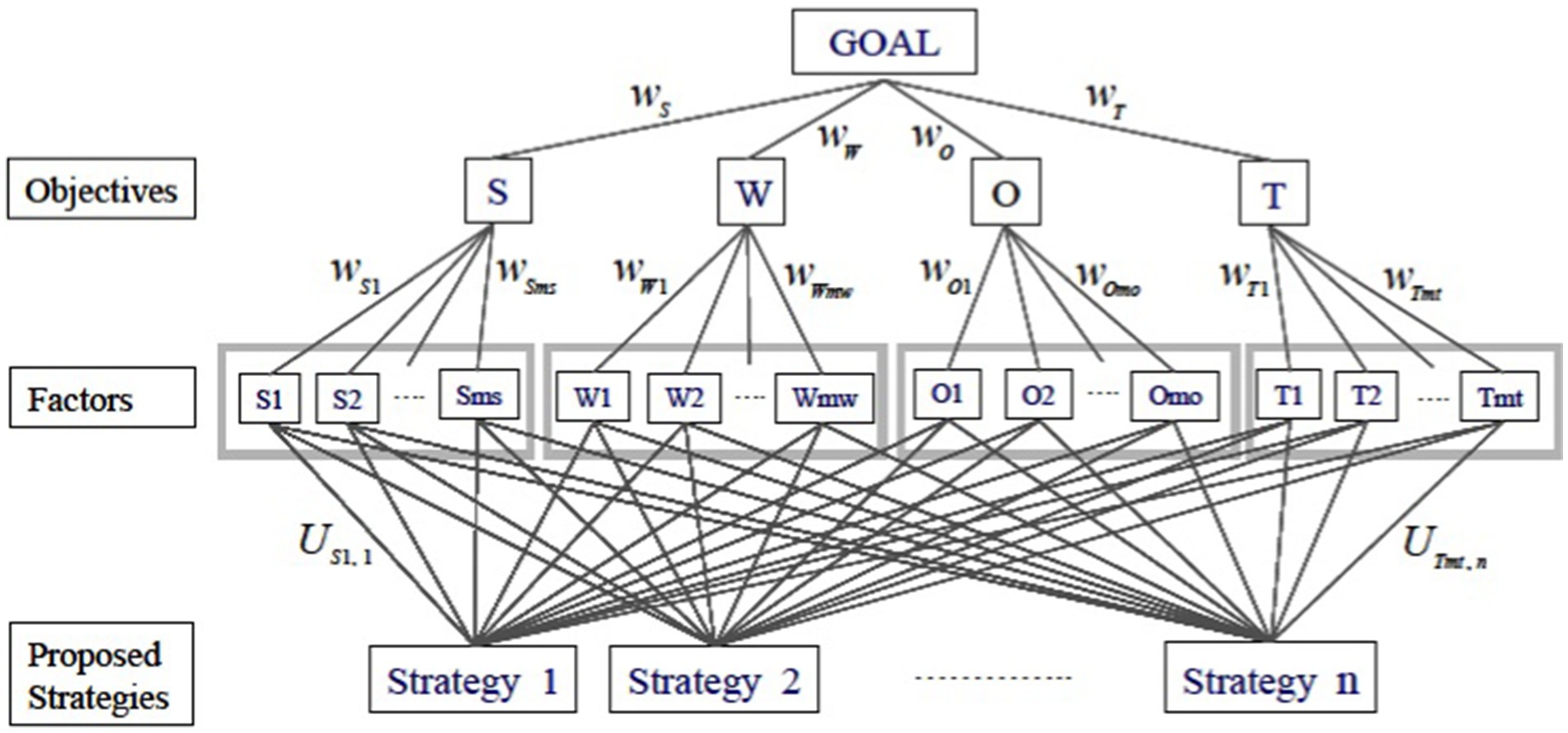
Figure 6. The AHP model to select the suitable strategy for stabilizing the livelihood of smallholders through non-farm activities (derived from Osuna and Aranda, 2007).
As shown in the Table 2, each of the criteria and sub-criteria was completed through the questionnaire by the studied population, which are Agricultural Extension Experts at the agriculture Organization of Province and Experts at the General Office of Cultural Heritage, Tourism, and Handicraft of Province.
Data were operationalized in the Expert Choice and Excel software packages. In this step, the weights of the main factors (strengths, weaknesses, opportunities, and threats) were first calculated (RW in Table 3). Then, the weights of the subcriteria were calculated (RP in Table 3). Finally, Eq. (1) was used to rank the subcriteria (TP in Table 3) as follows:
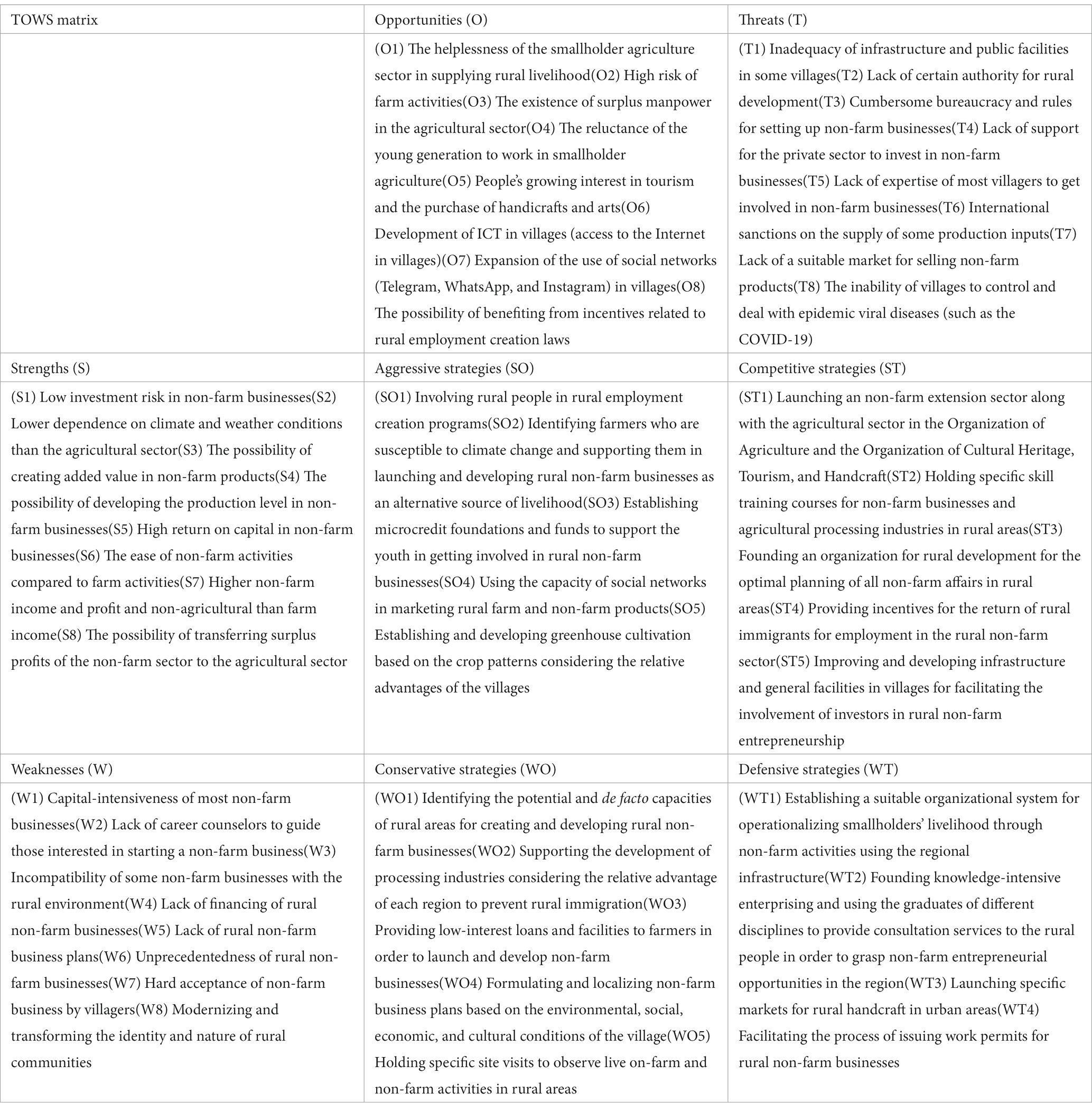
Table 5. The TOWS matrix to determine strategies for formulating smallholders’ livelihood stabilization strategies.
In this formula: Relative Weight (RW), Relative Priority (RP) and Total Prioritization (TP).
3.5. TOWS analysis
Although the SWOT analysis provides a clear understanding of the internal and external environment of a phenomenon and specifies the strategic space of the subject, this matrix does not propose a strategy for improving the status quo (Şeker and Özgürler, 2012). The TWOS matrix is an instrument that is usually applied after the SWOT matrix to help propose strategies for improving the present and future status (Gottfried et al., 2018). The TOWS matrix is extensively used to determine strategies for which it relies on strengths, weaknesses, opportunities, and threats (Asadpourian et al., 2020). In the TOWS matrix, the crossing of strengths, weaknesses, opportunities, and threats yields four types of strategies including WT, ST, WO, and SO (Şeker and Özgürler, 2012; Asadpourian et al., 2020).
• SO: All organizations seek ways to maximize their strengths and opportunities simultaneously.
• WO: Adaptive strategies try to take the most advantage of the existing opportunities by reducing the weaknesses.
• ST: These strategies are based on exploiting strengths in coping with threats and aim to maximize strengths and minimize threats.
• WT: These strategies, which can be called “survival” strategies, generally aim to reduce weaknesses in order to reduce or neutralize threats.
Each strategy is usually a mixture of several subcriteria. To calculate the weight of each strategy, the weights of the respective subcriteria should be multiplied. Eq. (2) was considered for calculating the weight of the strategies.
4. Results
4.1. Identifying the fourfold points of SWOT for the analysis of the status quo
After reviewing the theoretical literature, 16 external points (8 opportunities and 8 threats) and 16 internal points (8 strengths and 8 weaknesses) were identified for formulating strategies for stabilizing the livelihood of smallholders through non-farm activities (Table 4).
4.2. Relative importance of criteria and sub criteria affecting the development of strategies for stabilizing the livelihood of smallholders
To calculate and rank the criteria and sub criteria that affect the development of strategies for stabilizing the livelihood of smallholders, we should first assign weights to the fourfold criteria of SWOT (strengths, weaknesses, opportunities, and threats). Thus, the weights of the SWOT criteria were specified by their pairwise comparison. Based on the results, the strengths and weaknesses whose weights were 0.391 and 0.276, respectively had the greatest impact on the development of strategies for stabilizing the livelihood of smallholders through non-farm activities (Figure 7).
In the next step, the weights of the individual sub criteria in formulating strategies for stabilizing the livelihood of smallholders through non-farm activities were estimated (Table 5). According to the results, the most important factors underpinning the development and formulation of strategies for stabilizing the livelihood of smallholders through non-farm activities included “lower dependence on climate and weather conditions than the agricultural sector” among strengths, “capital-intensiveness of most non-farm businesses” among weaknesses, “the helplessness of the smallholder agriculture sector in supplying rural livelihood” among opportunities, and “lack of expertise of most villagers to get involved in non-farm businesses” among threats.
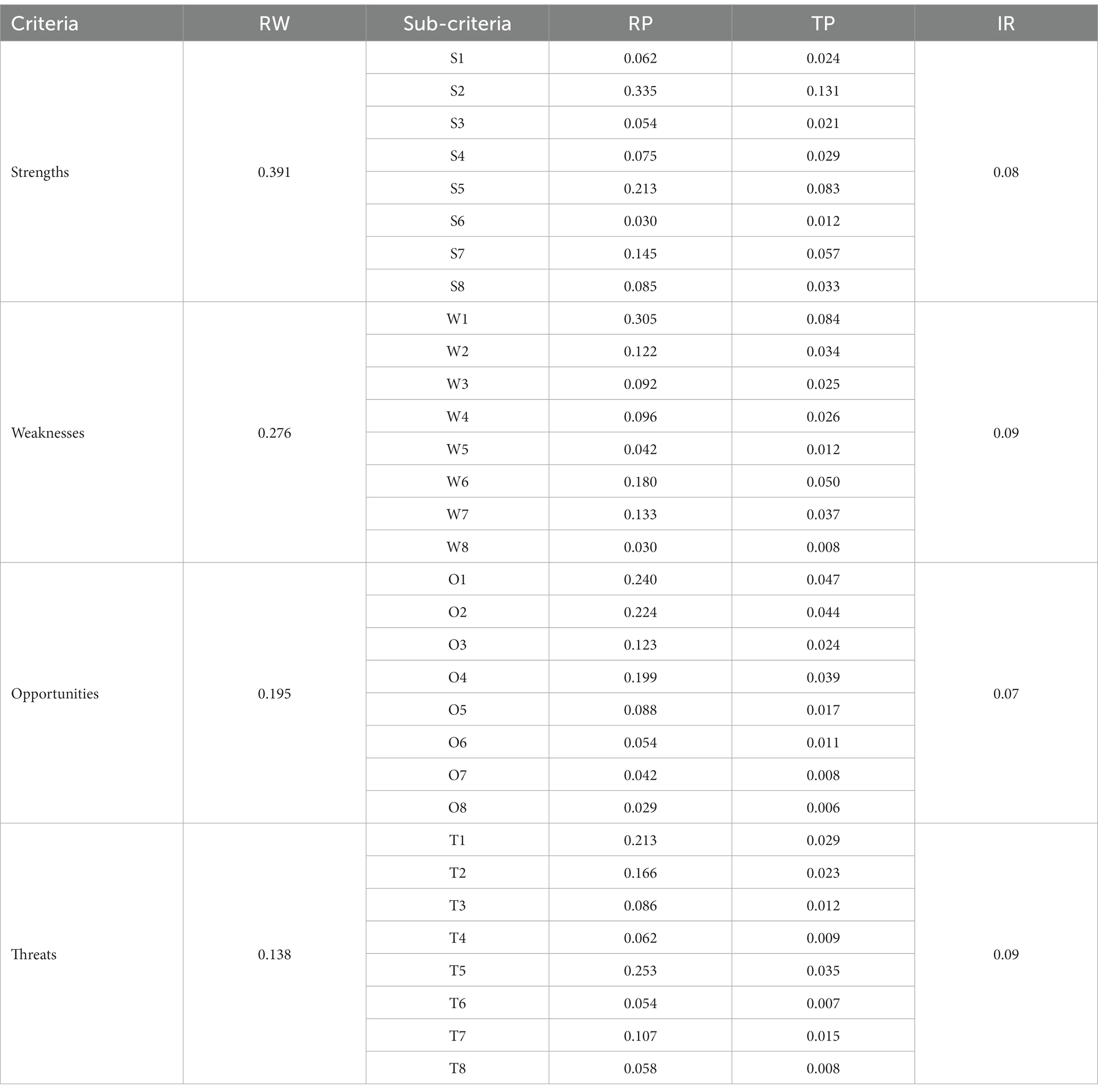
Table 3. The ranking of the sub criteria studied for the development of strategies for stabilizing the livelihood of smallholders.
4.3. Analysis of the strategic space of the development of strategies for stabilizing the livelihood of smallholders
The results of the analysis of the strategic space of the development of strategies for stabilizing the livelihood of smallholders through non-farm activities revealed that strengths (0.391) were more important than weaknesses (0.276) in the internal environment and that opportunities (0.195) were more important than threats (0.138) in the external environment. Also, it was found that internal challenges (S + W = 0.667) were more important than external challenges (O + T = 0.333) in developing livelihood stabilization strategies. The beneficial environment (O + S = 0.586) was also found to dominate the risky environment (T + W = 0.414) (Table 4; Figure 8).
According to the ranking of the strategic zones, the first strategy is based on ST, i.e., the contingency strategy (max-min). This strategy tries to take advantage of the strengths to cope with the threats. It aims to maximize the strengths for tackling all threats. However, caution should be exercised in this strategy because the improper use of power can have undesirable effects. The second strategy is SO, i.e., the aggressive strategy (max-max) in which the whole system pursues a situation in which it can maximize both its strengths and opportunities. In these conditions, the organization aims to use its strengths for grasping the existing opportunities. The third strategy is based on WT, which is the defensive strategy (min-min). This strategy, which is also called the “survival strategy,” is based on reducing the existing weaknesses in order to cope with the threats. Finally, the last strategy is based on WO, i.e., the adaptive strategy (min-max) which tries to reduce weaknesses in order to maximize the use of the existing opportunities. For example, an organization may detect some opportunities in its external environment, but cannot grasp them due to its weaknesses. In these conditions, the adaptive strategy can help take advantage of the opportunities (Figure 9).
4.4. Developing and ranking livelihood stabilization strategy using the TOWS matrix
In this step, the strategic TOWS matrix was used to develop strategies for stabilizing the livelihood of smallholders through non-farm activities. The results are presented in Table 5. Accordingly, some strategies were developed for each zone. The result was 20 strategies for stabilizing the livelihood of smallholders through non-farm activities.
Table 6 presents the pairwise comparisons and the final weights of the factors at four strategic levels. It also specifies the sub criteria used in each strategy. According to the results, the most important strategies included “establishing and developing greenhouse cultivation based on the crop patterns considering the relative advantages of the villages” and “establishing microcredit foundations and funds to support the youth in getting involved in rural non-farm businesses,” and the weakest ones included “facilitating the process of issuing work permits for rural non-farm businesses” and “improving and developing infrastructure and general facilities in villages for facilitating the involvement of investors in rural non-farm entrepreneurship.”
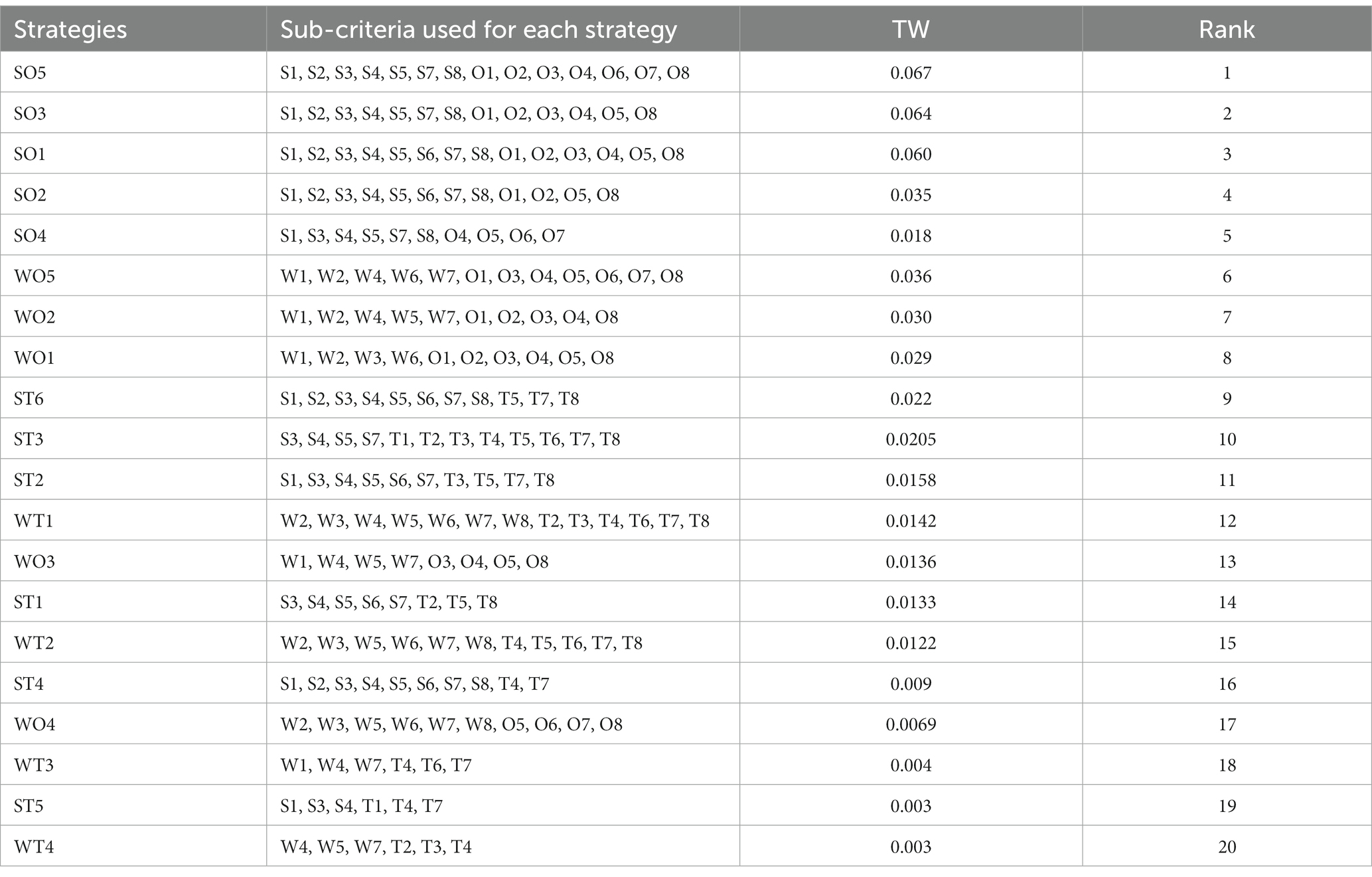
Table 6. The ranking of the strategies for stabilizing the livelihood of smallholders through non-farm activities.
5. Discussion
While some researchers (e.g., Markakis, 2004; Kinuthia and Wahome, 2019) argue that livelihood that is based on traditional farming and ranching is being ruined, others (e.g., Freier et al., 2012; Dehghanipour et al., 2018; Su et al., 2019; Savari et al., 2022) have investigated the reasons for the susceptibility of livelihood to external disruptions such as climate change and suggested that households are capable enough of achieving sustainable livelihood by the sound use of their capitals and the adoption of a suitable livelihood strategy (Savari and Shokati Amghani, 2019). Therefore, to retain the sustainability of their livelihood over time, households select their livelihood based on a combination of their capital (Jiao et al., 2017; Rockenbauch et al., 2019; Zhang and Fang, 2020).
It is worth noting that so far various strategies have been proposed for the supply of sustainable livelihood at the international level. A famous example is the formation of the Committee on Sustainable Development Goals by 193 UN member states in 2015, which aims to eradicate poverty from the world (Fritz et al., 2009; Christiaensen et al., 2013). There are, however, diverse barriers to achieving sustainable livelihood, which prevent the stabilization of farmers’ livelihood. An example is the seasonality of farm activities, making farmers dependent on seasonal and atmospheric changes, which is a big challenge to supplying their livelihood. In this respect, non-farm activities will be the most suitable complementary or alternative strategy (Abdollahzadeh et al., 2016). Also, the extensive climate change of recent decades has exposed the agricultural sector to multiple challenges, such as global warming, landslides, land subsidence, natural disasters like floods, fires, forest and pasture fires, drought, the invasion of plant diseases and pests like grasshoppers, and the salinization of groundwater resources and soils (World Bank, 2021; Savari et al., 2023a,b). Indeed, Iranian researchers have projected that the annual mean temperature in different parts of Iran will increase by 3.5–4.5°C whereas the mean annual precipitation will decrease by 7–14% by 2051. These changes will also be more extreme as one moves from the west to the east and from the north to the south. The temperature rise extends the agricultural growing season due to the increase in the number of frost-free days. The decline in precipitation will also increase dry season duration in a range from about 20 days in the western regions to over 30 days in the southern regions, which is of higher importance in rainfed cultivation areas. The temperature rise will also increase annual potential evapotranspiration by 18–30% by 2051. This will widen the difference between the precipitation rate and potential evapotranspiration, i.e., the precipitation shortage index, which will be mainly related to the increase in evapotranspiration (Koocheki et al., 2015). Considering the serious threats of water scarcity, drought has drawn scientists’ attention in recent decades. Research around the world shows that this crisis has already started in China, Africa, India, Thailand, Mexico, Egypt, and Iran and the major rivers of the world including the Nile in Egypt, the Ganges in South Asia, the Yellow River in China, and the Colorado River in the US have seriously been threatened. Even, the water reserves of the 11 main rivers of the UK have decreased to one-third (Wines, 2014). In addition to the water loss of the rivers, the water resources of numerous lakes and inland and outland wetlands have already been dried completely or depleted severely. Examples include Lake Urmia, Bakhtegan Lake, Arzhan Lake, Tashk Lake, Parishan Lake, and Hamun Wetland in Iran, Poopó Lake in Bolivia, Colorado Lake in the US, the Aral Sea on the borderline of Kazakhstan and Uzbekistan, Lake Powell, Lake Chad, and many others, which have now no water, deeply challenging the life of humans, animals, and plants and consequently jeopardizing the supply of sustainable livelihood for local people (Lak et al., 2011). Accordingly, climate change is one of the most fundamental challenges of human communities, in addition to its effect on people’s livelihoods. Drought, as one of the most important and costly climatic phenomena, has affected the livelihood of rural households by imposing more economic and social harms in arid regions (Nasrnia and Ashktorab, 2021). On the other hand, the partial and overall productivity of the agricultural sector has diminished and it cannot adapt to technological developments either because of the loss of agricultural lands due to land-use changes and the fragmentation of agricultural fields. So, the burden on the agricultural sector should be reduced by transferring surplus farmers to the industrial sector. In this regard, FAO statistics show that the agricultural land area has decreased from 1961 to 2019 (FAOSTAT, 2021). The data of the International Labor Organization regarding the share of the agricultural sector in total employment at the international level also reveals the fact that this sector is no longer capable of supplying the livelihood of the target community due to the challenges in exploiting basic production resources. Indeed, the share of this sector in global employment has decreased from 40% in 2000 to 28% in 2020 (ILOSTAT, 2021). Similarly, the agricultural sector has been the only sector with a negative growth rate (−3.9) in Iran based on a report of the national economic growth rate in the 9 months of 2021 provided by the Statistical Center of Iran. Unlike the agricultural sector, we are witnessing 7.1 and 5.1% economic growth rates in the industrial and service sectors, respectively, reflecting potential investment opportunities in these sectors at the national and rural levels (Statistical Center of Iran, 2022).
This research pursued two general objectives: (1) examining the status of the strategic environment of sustainable livelihood of smallholders through non-farm activities and (2) developing strategies for sustainable livelihood of smallholders through non-farm activities. So, the results can help countries that face the unsustainability of smallholders’ livelihoods to stabilize their livelihood by adopting these strategies. Furthermore, since no combined research has been conducted on our subject matter yet, the present research can contribute to the literature and fill the gap in previous studies.
In this research, we used the combined SWOT-AHP-TOWS index to specify the strategic status of smallholders’ livelihood sustainability through non-farm activities. In the SWOT analysis, the measured weights of the factors are typically used to determine their effect on the strategy choices. The SWOT analysis does not provide the relative importance of the criteria in a systematic way and acts upon the examination of the decision alternatives in terms of the criteria. To cope with this shortage, the SWOT framework (conceptual model) is converted into a hierarchical structure, the model is integrated, and the AHP is used for analysis by calculating their eigenvalues. By integrating the AHP into the SWOT framework, it is intended to systematically rank the SWOT factors in terms of their importance (Savari and Amghani, 2022).
The assessment of the internal points (strengths and weaknesses) revealed that the most important strength in stabilizing the livelihood of smallholders through non-farm activities was “lower dependence on climate and weather conditions than the agricultural sector.” Regarding this finding, it can be inferred that agriculture is a high-risk activity as farmers are faced with various types of climatic risks, pests, diseases, market risks, and raw material risks (Skees et al., 1999), whereas the diversity and severity of these risks are lower in non-farm activities. In other words, a wide range of risks influences farm income (Zhang et al., 2023), such as production risk, price or market risk, financial risk, and human risk. These risks vary in role and importance in different regions depending on the temporal and spatial conditions and government policies (Bielza et al., 2008). It should be noted that drought and severe heat (e.g., heat waves) among extreme conditions can be unbelievably destructive with extensive effects on different agricultural sectors, so they may lead to natural disasters and draw public attention. With the increase in the mean global temperature, the frequency and intensity of droughts and extreme heat have increased and are expected to keep increasing, posing plenty of risks to different sectors, including agriculture (Leng et al., 2015; Chen et al., 2018; Dai et al., 2020; Han et al., 2021).
The results of the internal assessment of the research also showed that the most important weakness in stabilizing the livelihood of smallholders through non-farm activities was “capital-intensiveness of most non-farm businesses.” It can be interpreted that non-farm businesses are mostly of industrial type and sometimes need capital-intensive industrial manufacturing instruments that are unaffordable by rural households (Bordoloi, 2017, 2020). For example, a study in Bangladesh reported capital shortage as a key barrier to developing the rural non-farm sector (Rahbari et al., 2017).
Regarding the external points, “the helplessness of the smallholder agriculture sector in supplying rural livelihood” among the opportunities and “lack of expertise of most villagers to get involved in non-farm businesses” among the threats were the most important external factors influencing the development of strategies for stabilizing the livelihood of smallholders through non-farm activities. According to this finding, although the helplessness of the agricultural sector in supplying rural livelihood is by itself a threat to the community of smallholders, it can be an opportunity for entering into rural non-farm employment. There is a consensus in the literature of development studies that agriculture will fail to provide “productive employment” for the growing surplus rural population in the future decades. Here, the concept of “productive” employment can be well considered as achieving full and productive employment for all, including people in economically active age groups and women, as a part of the US 2030 agenda for sustainable development (United Nations, 2015). It is argued that despite the significant growth of agricultural production in several developing countries due to technological innovations, the capacity of the agricultural sector for workforce recruitment has not been satisfactory, especially in regions with inappropriate per capita land area and high rural population density (Lanjouw and Lanjouw, 1995; Simmons and Supri, 1997; Bhalla, 2005). Thus, a good deal of attention has been paid to the rural non-farm sector (RNFS) in the academic literature and in development planning and policy circles (Bordoloi, 2020). RNFS is an alternative for rural development in creating non-farm job opportunities in rural areas.
Regarding the lack of expertise among rural people to start non-farm businesses as a threat to stabilizing the livelihood of smallholders, it cannot be inferred that non-farm businesses are ambiguous, complicated, and unfamiliar for rural people because they did not use to exist in rural areas. So, most rural people have no adequate knowledge to get involved in non-farm businesses, and this is an obstacle to entering into this sector (Rahbari et al., 2017).
The analysis of the strategic space of the development of strategies for stabilizing the livelihood of smallholders through non-farm activities revealed that the strengths were more important than the weaknesses in the internal space and the opportunities were more important than the threats in the external space. Also, it was found that internal challenges are more important than external challenges in developing livelihood stabilization strategies. According to these results, the beneficial space dominates the risky environment. So, policymakers need to address the weaknesses and threats that threaten smallholders by adopting important policies as soon as possible as it will help farmers to stabilize their livelihood by promoting their strengths, alleviating their weaknesses, coping with the threats, and grasping the opportunities (Savari and Shokati Amghani, 2021; Savari and Amghani, 2022).
Finally, drawing on the TOWS matrix, the research developed 20 strategies for stabilizing the livelihood of smallholders through non-farm activities. The results in this section showed that the two strategies of “establishing and developing greenhouse cultivation based on the crop patterns considering the relative advantages of the villages” and “establishing microcredit foundations and funds to support the youth in getting involved in rural non-farm businesses” were the most important strategies for stabilizing the livelihood of smallholders through non-farm activities. In this regard, policymakers are recommended to take the strategies developed for livelihood stabilization seriously. Also, the following policies are recommended:
• Changing the approach of government support in the field of granting microcredits to smallholders: increasing production by providing credits and empowering smallholding units, and consequently, increasing employment and bringing economic balance between the agricultural and non-agricultural sectors.
• Developing infrastructural facilities and service: empowering the electricity grid in rural centers, facilitating the issuing of industrial power permits to the rural industrial activists, modifying roads and streets inside the rural areas, modifying roads connecting the farms, developing and expanding Internet access in rural areas, and developing warehouses and cold storage in central rural areas to preserve farm and non-farm products.
• Education: the development of non-farm employment requires suitable extension and educational programs. In this regard, it is necessary to provide technical and professional training for which governmental and non-governmental extension and educational institutions can be effective in developing non-farm employment because the certificates issued by the Technical and Professional Centers can be used to receive work permits and loans from the banking system.
6. Conclusion and Limitations
The purpose of the current study was to develop strategies for stabilizing the livelihood of smallholders through non-farm activities in four provinces of Alborz, Guilan, Hormozgan, and Yazd in Iran. To this end, the TOWS matrix was used, and 20 strategies were developed.
The main conclusion to be drawn from this study was the weights of the SWOT criteria were specified by their pairwise comparison. Based on the results, the strengths and weaknesses whose weights were 0.391 and 0.276, respectively had the greatest impact on the development of strategies for stabilizing the livelihood of smallholders through non-farm activities. Therefore, it is concluded that strengths can have the greatest impact in Developing strategies for stabilizing the livelihood of smallholder farmers through non-farm activities. Considering that the strengths are internal factors, it is possible to change and improve them in order to deal with the threats and also take maximum advantage of the opportunities. According to the ranking of the strategic zones, the first strategy is based on ST, i.e., the contingency strategy (max-min). This strategy tries to take advantage of the strengths to cope with the threats. It aims to maximize the strengths for tackling all threats. However, caution should be exercised in this strategy because the improper use of power can have undesirable effects. This study showed that presents the pairwise comparisons and the final weights of the factors at four strategic levels. It also specifies the sub criteria used in each strategy. The most obvious finding to emerge from this study was that, the most important strategies included “establishing and developing greenhouse cultivation based on the crop patterns considering the relative advantages of the villages” and “establishing microcredit foundations and funds to support the youth in getting involved in rural non-farm businesses,” and the weakest ones included “facilitating the process of issuing work permits for rural non-farm businesses” and “improving and developing infrastructure and general facilities in villages for facilitating the involvement of investors in rural non-farm entrepreneurship.”
In this research, it is true that we achieved valuable results that showed that non-agricultural activities can play an effective role in stabilizing the livelihood of smallholder farmers, but the important point is that the policymaking of non-agricultural activities is carried out in a separate organization from the agricultural organization. Unfortunately, they have no interaction or cooperation with each other. Even in some cases, these two organizations have a conflict of interest with each other. A clear example of that is agricultural land use change for the development of rural tourism. Therefore, countries will succeed in stabilizing farmers’ livelihoods through non-farm activities if all matters related to sustainable rural development, including agricultural development and rural non-farm development, are planned and politicized through a single organization. Therefore, the feasibility of forming a rural development organization consisting of two agricultural and non-agricultural sectors can be considered by other researchers as future research.
Despite its important results, the research suffers from two limitations. First, it was conducted only in four Iranian provinces of Alborz, Guilan, Hormozgan, and Yazd, so we should be cautious in generalizing its results to other regions. Second, it was single-sectional in time. It is considerable that this research was conducted at a time when the entire country of Iran was involved in the COVID-19 epidemic, and for this reason, access to farmers and experts was very difficult.
Data availability statement
The raw data supporting the conclusions of this article will be made available by the authors, without undue reservation.
Ethics statement
Ethical review and approval was not required for the study on human participants in accordance with the local legislation and institutional requirements. Written informed consent from the participants was not required to participate in this study in accordance with the national legislation and the institutional requirements.
Author contributions
JB, MSS, MSA, and AN contributed to the study’s conception and design. Material preparation, data collection, and analysis were performed by JB, MSS, MSA, and AN. The first draft of the manuscript was written by MSS. All authors contributed to the article and approved the submitted version.
Conflict of interest
The authors declare that the research was conducted in the absence of any commercial or financial relationships that could be construed as a potential conflict of interest.
Publisher’s note
All claims expressed in this article are solely those of the authors and do not necessarily represent those of their affiliated organizations, or those of the publisher, the editors and the reviewers. Any product that may be evaluated in this article, or claim that may be made by its manufacturer, is not guaranteed or endorsed by the publisher.
References
Abdollahzadeh, G., Salehi, K., Sharifzadeh, M. S., and Khajehshahkohi, A. (2016). Investigating the impact of tourism on sustainable rural livelihoods in Golestan Province. J. Tour. Plan. Dev. 4, 148–169.
Abebe, T G. (2012). Farm assets and nonfarm activities characteristic and determinants of nonfarm activities in small holder farmers: The case of North east Ethiopia, Tehuledere District. Thesis submitted to the Wageningen University and Research Centre in Partial Fulfilment of the Requirements for the Master of Science Degree of Master’s in Management, Economics and Consumer Studies.
Abimbola, A. O., and Oluwakemi, O. A. (2013). Livelihood diversification and welfare of rural households in Ondo State. Nigeria, J. Dev Agric Econ. Analysis of theory and practice, Geographical Paper No. 189.
Alavizadeh, A. M., and Mir Lotfi, M. R. (2013). The role of non-farm economy on rural immobility in rural settlements: (Semirom country). J. Reg. Plan. 3, 71–82.
Asadpourian, Z., Rahimian, M., and Gholamrezai, S. (2020). SWOT-AHP-TOWS analysis for sustainable ecotourism development in the best area in Lorestan Province, Iran. Soc. Indic. Res. 152, 289–315. doi: 10.1007/s11205-020-02438-0
Asfaw, A., Simane, B., Hassen, A., and Bantider, A. (2017). Determinants of non-farm livelihood diversification: evidence from rainfed-dependent smallholder farmers in northcentral Ethiopia (Woleka sub-basin). Dev. Stud. Res. 4, 22–36.
Bhalla, S. (2005). Rural workforce diversification and performance of unorganised sector enterprises. Rural transformation in India: The role of non-farm sector, 75–104.
Bielza, M, Conte, C, Dittmann, CH, Gallego, J, and Stroblmair, J. (2008). Agricultural insurance schemes, Institute for the Protection and Security of the Citizen, Agriculture and Fisheries Unit.
Black, R., and Cobbinah, P. B. (2018). Local attitudes towards tourism and conservation in rural Botswana and Rwanda. J. Ecotour. 17, 79–105. doi: 10.1080/14724049.2016.1258074
Bojnec, Š., and Knific, K. (2021). Farm household income diversification as a survival strategy. Sustainability 13:6341. doi: 10.3390/su13116341
Bordoloi, S. (2017). The rural nonfarm sector in flexible capitalism: the coir industry in Kerala, India. Hum. Geograp. 10, 50–66. doi: 10.1177/194277861701000105
Bouraima, M. B., Qiu, Y., Yusupov, B., and Ndjegwes, C. M. (2020). A study on the development strategy of the railway transportation system in the west African economic and monetary union (WAEMU) based on the SWOT/AHP technique. Sci. Afr. 8:e00388. doi: 10.1016/j.sciaf.2020.e00388
Charaghi, M., Mohammadi Yeganeh, B., and Musavi Zare, S. S. (2018). The role of non-farm activities on the food security of rural households case study: Fazl rural district, Nishabour city. Rural Dev. Strat. 5, 51–66. doi: 10.22048/rdsj.2018.53551.1541
Chen, Y., Zhai, P., and Zhou, B. (2018). Detectable impacts of the past half-degree global warming on summertime hot extremes in China. Geophys. Res. Lett. 45, 7130–7139. doi: 10.1029/2018GL079216
Christiaensen, L., Pan, L., and Wang, S. (2013). Pathways out of poverty in lagging regions: evidence from rural western China. Agric. Econ. 44, 25–44. doi: 10.1111/j.1574-0862.2012.00630.x
Dai, M., Huang, S., Huang, Q., Leng, G., Guo, Y., Wang, L., et al. (2020). Assessing agricultural drought risk and its dynamic evolution characteristics. Agric. Water Manag. 231:106003. doi: 10.1016/j.agwat.2020.106003
Dehghanipour, M., Barati, A. A., Azadi, H., and Scheffran, J. (2018). Revealing the role of livelihood assets in livelihood strategies: towards enhancing conservation and livelihood development in the Hara biosphere reserve, Iran. Ecol. Indic. 94, 336–347. doi: 10.1016/j.ecolind.2018.05.074
Do, T. L., Nguyen, T. T., and Grote, U. (2019). Nonfarm employment and household food security: Evidence from panel data for rural Cambodia. Food Secur. 11, 703–718.
Esmaeili, M., Ghasemi, M., and Bouzarjomehri, K. (2019). The efficacy of farm-nonfarm diversification on rural households’ quality of life (case study: Golmakan Dehestan of Chenaran County). J. Res. Rural Plan. 8, 23–44. doi: 10.22067/jrrp.v8i1.67389
FAOSTAT (2021). Food and agriculture data. Available at: https://www.fao.org/faostat/en/#home (Accessed July 1, 2022).
Freier, K. P., Bruggemann, R., Scheffran, J., Finckh, M., and Schneider, U. A. (2012). Assessing the predictability of future livelihood strategies of pastoralists in semi-arid Morocco under climate change. Technol. Forecast. Soc. Chang. 79, 371–382. doi: 10.1016/j.techfore.2011.07.003
Fritz, D., Miller, U., Gude, A., Pruisken, A., and Rischewski, D. (2009). Making poverty reduction inclusive: experiences from Cambodia, Tanzania and Vietnam. J. Int. Dev. 21, 673–684. doi: 10.1002/jid.1595
Ghazinoory, S., Abdi, M., and Azadegan-Mehr, M. (2011). SWOT methodology: a state-of-the-art review for the past, a framework for the future. J. Bus. Econ. Manag. 12, 24–48. doi: 10.3846/16111699.2011.555358
Gottfried, O., De Clercq, D., Blair, E., Weng, X., and Wang, C. (2018). SWOT-AHP-TOWS analysis of private investment behavior in the Chinese biogas sector. J. Clean. Prod. 184, 632–647. doi: 10.1016/j.jclepro.2018.02.173
Gürel, E., and Tat, M. (2017). SWOT ANALYSIS: a THEORETICAL REVIEW Uluslararası Sosyal Araştırmalar Dergisi the journal of international. Soc. Res. 10, 994–1006. doi: 10.17719/jisr.2017.1832
Haggblade, S., Hazell, P., and Reardon, T. (2005). The rural nonfarm economy: Pathway out of poverty or pathway in?” in International Food Policy Research Institute. The future of small farms. Proceedings of a research workshop, Wye, UK, 151–178.
Hajian, N., and Ghasemi, M. (2021). The role of diversity of income sources on the vulnerability of rural farmer households exposed to drought (case study: Chenaran County). Emerg. Manag. 10, 141–155.
Hajian, N., Ghasemi, M., and Mofidi, A. (2019). The role of variety of economic-agronomic and non-agricultural activities on the resilience of farmers’ rural households in the areas exposed to drought (case study: Chenaran County). J. Geograp. Environ. Haz. 7, 31–52 doi: 10.22067/geo.v0i0.71994
Han, Z., Huang, Q., Huang, S., Leng, G., Bai, Q., Liang, H., et al. (2021). Spatial-temporal dynamics of agricultural drought in the loess plateau under a changing environment: characteristics and potential influencing factors. Agric. Water Manag. 244:106540. doi: 10.1016/j.agwat.2020.106540
Haque, H. E., Dhakal, S., and Mostafa, S. M. G. (2020). An assessment of opportunities and challenges for cross-border electricity trade for Bangladesh using SWOT-AHP approach. Energy Policy 137:111118. doi: 10.1016/j.enpol.2019.111118
Heidari-Sareban, V., and Majnouni-Toutakhaneh, A. (2017). The role of livelihood diversity on the resilience of rural households living around the Lake Urmia against drought. JSAEH 3, 49–70. doi: 10.18869/acadpub.jsaeh.3.4.49
Hosseini, K., Forouzani, M., and Abdeshahi, A. (2022). Investigating the relationship between economic and social sustainability and livelihood diversity. Iran. Agric. Exten. Educ. J. 17, 11–27.
ILOSTAT (2021). The leading source of labor statistics. Available at: https://ilostat.ilo.org/ (Accessed July 1, 2022).
Iqbal, M. A., Rizwan, M., Abbas, A., Makhdum, M. S. A., Kousar, R., Nazam, M., et al. (2021). A quest for livelihood sustainability? Patterns, motives and determinants of non-farm income diversification among agricultural households in Punjab, Pakistan. Sustainability 13:9084. doi: 10.3390/su13169084
Jami, M. (2016). Evaluation of the role and position of non-agricultural activities based on horticulture in diversifying the rural economy, case study: Mahabad county. Dissertation to receive a master's degree in the field of geography and rural planning - sustainable development management. Faculty of Humanities. University of Zanjan.
Jiao, X., Pouliot, M., and Walelign, S. Z. (2017). Livelihood strategies and dynamics in rural Cambodia. World Dev. 97, 266–278.
Kangas, J., Kurttila, M., Kajanus, M., and Kangas, A. (2003). Evaluating the management strategies of a forestland estate—the SOS approach. J. Environ. Manag. 69, 349–358. doi: 10.1016/j.jenvman.2003.09.010
Keshavarz, M., and Karami, E. (2012). Stabilization of rural livelihoods: the challenge of the agricultural extension system in drought conditions. The 4th congress of science of agriculture and natural resources extension and education of Iran, University of Tehran.
Kinuthia, V. N., and Wahome, R. G. (2019). Attitudes on land-use systems and social mindset transformations after group ranch subdivision in Kenya. Land Use Policy 87:104004. doi: 10.1016/j.landusepol.2019.05.023
Koocheki, A., Nasiri Mahalati, M., and Jafari, L. (2015). Evaluation of climate change effect on agricultural production of Iran: I. predicting the future Agroclimatic conditions. Iranian journal of. Field Crop Res. 13, 651–664. doi: 10.22067/gsc.v13i4.51156
Kubler, S., Robert, J., Derigent, W., Voisin, A., and Le Traon, Y. (2016). A state-of the-art survey & testbed of fuzzy AHP (FAHP) applications. Expert Syst. Appl. 65, 398–422. doi: 10.1016/j.eswa.2016.08.064
Kumar, S., Soukup, M., and Elbaum, R. (2017). Silicification in grasses: variation between different cell types. Front. Plant Sci. 8:438. doi: 10.3389/fpls.2017.00438
Lak, R., Darvishi Khatouni, J., and Mohammadi, A. (2011). Paleolimnology studies and the causes of the sudden decrease in the water level of Lake Urmia. J. Geotech. Geol. 7, 343–358.
Lanjouw, J. O., and Lanjouw, P. (1995). Rural nonfarm employment (no. 1463). Lanjouw World Bank Publications.
Leng, G., Tang, Q., and Rayburg, S. (2015). Climate change impacts on meteorological, agricultural and hydrological droughts in China. Glob. Planet. Chang. 126, 23–34. doi: 10.1016/j.gloplacha.2015.01.003
Mahdi, G., Shivakoti, G., and Schmidt-Vogt, D. (2009). Livelihood Change and livelihood sustainability in the uplands of lembang subwatershed west Sumatra Indonesia in a changing natural resource management context. Environ. Manage. 43, 84–99.
Masoumi, E., and Hayati, D. (2016). Direction of rural development through entrepreneurial strategy of non-agricultural economy. J. Stud. Entrep. Sustain. Agric. Dev. 4, 71–87. doi: 10.22069/JEAD.2018.14001.1286
Nasrnia, F., and Ashktorab, N. (2021). Sustainable livelihood framework-based assessment of drought resilience patterns of rural households of Bakhtegan basin, Iran. Eco. Indic. 128:107817. doi: 10.1016/j.ecolind.2021.107817
Noshad, M., Hojjati, M., and Behbahani, B. A. (2018). Black Zira essential oil: chemical compositions and antimicrobial activity against the growth of some pathogenic strain causing infection. Microb. Pathog. 116, 153–157. doi: 10.1016/j.micpath.2018.01.026
Opricovic, S., and Tzeng, G. H. (2004). Compromise solution by MCDM methods: a comparative analysis of VIKOR and TOPSIS. Eur. J. Oper. Res. 156, 445–455. doi: 10.1016/S0377-2217(03)00020-1
Osuna, E. E., and Aranda, A. (2007). Combining SWOT and AHP techniques for strategic planning. ISAHP 2007, 1–8.
Pourkashani, M. (2022). The story of the water cycle in Iran. Available at: https://d-mag.ir/p4346/ (Accessed July 1, 2022).
Rahbari, M., Shafie Sabet, N., and Rezaai, Z. (2017). Analysis of the factors affecting the diversification of non-agricultural economics and its impact on the sustainability of rural settlements: a case study of Sarvelayat division, Neyshabur County. J. Geograp. Reg. Dev. 15, 237–258. doi: 10.22067/geography.v15i1.59424
Rashidin, M. S., Javed, S., Liu, B., and Jian, W. (2020). Ramifications of households’ nonfarm income on agricultural productivity: evidence from a rural area of Pakistan. Sage Open 10:2158244020902091.
Rockenbauch, T., Sakdapolrak, P., and Sterly, H. (2019). Beyond the local–Exploring the socio-spatial patterns of translocal network capital and its role in household resilience in Northeast Thailand. Geoforum 107, 154–167.
Savari, M., and Amghani, M. S. (2022). SWOT-FAHP-TOWS analysis for adaptation strategies development among small-scale farmers in drought conditions. Int. J. Disaster Risk Red. 67:102695. doi: 10.1016/j.ijdrr.2021.102695
Savari, M., and Moradi, M. (2022). The effectiveness of drought adaptation strategies in explaining the livability of Iranian rural households. Habitat Int. 124:102560. doi: 10.1016/j.habitatint.2022.102560
Savari, M., Sheheytavi, A., and Amghani, M. S. (2023b). Factors underpinning Iranian farmers’ intention to conserve biodiversity at the farm level. J. Nat. Conserv. 73:126419. doi: 10.1016/j.jnc.2023.126419
Savari, M., Sheheytavi, A., and Shokati Amghani, M. (2023a). Promotion of adopting preventive behavioral intention toward biodiversity degradation among Iranian farmers. Glob. Eco. Conserv. 43:e02450. doi: 10.1016/j.gecco.2023.e02450
Savari, M., Sheykhi, H., and Amghani, M. S. (2020). The role of educational channels in the motivating of rural women to improve household food security. One Health 10:100150. doi: 10.1016/j.onehlt.2020.100150
Savari, M., and Shokati Amghani, M. (2019). Identifying adaptation strategies for small-scale farmers in the face of drought in West Azerbaijan province. Spatial Plan. 9, 17–42. doi: 10.22108/sppl.2019.116467.1373
Savari, M., and Shokati Amghani, M. (2021). Factors influencing farmers’ adaptation strategies in confronting the drought in Iran. Environ. Dev. Sustain. 23, 4949–4972. doi: 10.1007/s10668-020-00798-8
Savari, M., Yazdanpanah, M., and Rouzaneh, D. (2022). Factors affecting the implementation of soil conservation practices among Iranian farmers. Sci. Rep. 12:8396. doi: 10.1038/s41598-022-12541-6
Şeker, Ş., and Özgürler, M. (2012). Analysis of the Turkish consumer electronics firm using SWOT-AHP method. Procedia Soc. Behav. Sci. 58, 1544–1554. doi: 10.1016/j.sbspro.2012.09.1141
Shabanali Fami, H., Shokati Amghani, M., Savari, M., Mohammadzadeh Nasrabadi, M., and Moetaghed, M. (2021). The role of non-farming activities in the sustainability of peasant farming systems: a case in Osku County. Int. J. Agric. Manag. Dev. 11, 297–312.
Shakerian, F., Kim, K. H., Kwon, E., Szulejko, J. E., Kumar, P., Dadfarnia, S., et al. (2016). Advanced polymeric materials: synthesis and analytical application of ion imprinted polymers as selective sorbents for solid phase extraction of metal ions. TrAC Trends Anal. Chem. 83, 55–69. doi: 10.1016/j.trac.2016.08.001
Shivakoti, G., and Schmidt-Vogt, D. (2008). Livelihood change and livelihood sustainability in the uplands of Lembang Subwatershed, West Sumatra Province of Indonesia, in a Changing Natural Resources Management Context. In Redefining Diversity & Dynamics of Natural Resources Management in Asia. 4, 19–43. Elsevier
Shokati Amghani, M., Kalantari, K., Asadi, A., and Fami, H. S. (2018). Investigating the effective factors on land dispersion and fragmentation in east Azarbayjan Province. Iran. J. Agric. Eco. Dev. Res. 49, 487–508. doi: 10.22059/IJAEDR.2017.237776.668459
Shokati Amghani, M., Savari, M., and Choobchian, S. (2022). Vulnerability assessment of Iran's rural-farmer households during COVID-19 pandemic. Front. Public Health 10:994922. doi: 10.3389/fpubh.2022.994922
Shokati Amqani, M., Eshaghi, R., Maheri, A., Rezaei, R., and Shabanali Fomi, H. (2016). Study barriers of tourism development in rural areas of Osku city (case study: Coastal Village AqGonbad). Quart. Geograph. Space 16, 23–37.
Simmons, C., and Supri, S. (1997). Rural development, employment and off-farm activities: a study of rural households in Rurka Kalan development block, North-west India. J. Rural Stud. 13, 305–318. doi: 10.1016/S0743-0167(97)00020-X
Skees, J. R., Hazell, P. B., and Miranda, M. J. (1999). New approaches to crop yield insurance in developing countries (no. 581–2016-39503).
Sojasi Qeidari, H., Shayan, H., and Nurbakhsh, R. Z. (2015). The analysis of non-farm entrepreneurship in improving the quality of life in the villages case: villages located in Shandiz area, Binaloud County. Serd 4, 55–76. doi: 10.18869/acadpub.serd.4.12.55
Solangi, Y. A., Tan, Q., Mirjat, N. H., and Ali, S. (2019). Evaluating the strategies for sustainable energy planning in Pakistan: an integrated SWOT-AHP and fuzzy-TOPSIS approach. J. Clean. Prod. 236:117655. doi: 10.1016/j.jclepro.2019.117655
Statistical Centre of Iran (2022). Available at: https://www.amar.org.ir/english#10291052-national-statistics (Accessed July 1, 2022).
Su, M. M., Wall, G., Wang, Y., and Jin, M. (2019). Livelihood sustainability in a rural tourism destination - Hetu town, Anhui province, China. Tour. Manag. 71, 272–281. doi: 10.1016/j.tourman.2018.10.019
United Nations (2015). Transforming our world: the 2030 agenda for sustainable development. Available at: https://www.un.org/ga/search/view_doc.asp?symbol=A/RES/70/1&Lang=E [Accessed September 16, 2019].
United Nations Office for Disaster Risk Reduction (2021). Tracking progress on food and agriculture-related SDG indicators 2021. United Nations.
Wines, M. (2014). "Colorado River drought forces a painful reckoning for states." New York Times, 5.
World Bank (2021). Available at: https://www.worldbank.org (Accessed July 1, 2022).
Yazdanpanah, M., Tajeri Moghadam, M., Savari, M., Zobeidi, T., Sieber, S., and Löhr, K. (2021). The impact of livelihood assets on the food security of farmers in southern Iran during the COVID-19 pandemic. Int. J. Environ. Res. Public Health 18:5310. doi: 10.3390/ijerph18105310
Zamzami, P., Poursaeed, A., and Farajolah Hoseini, S. (2022). A model to stabilization the livelihood of gardeners on the shores of Lake Urmia against late spring cold: using a grounded theory approach. Iran. J. Agric. Eco. Dev. Res. 53, 55–74. doi: 10.22059/ijaedr.2021.327178.669062
Zhang, Y., Hao, Z., and Zhang, Y. (2023). Agricultural risk assessment of compound dry and hot events in China. Agric. Water Manag. 277:108128. doi: 10.1016/j.agwat.2022.108128
Zhang, C., and Fang, Y. (2020). Application of capital-based approach in the measurement of livelihood sustainability: A case study from the Koshi River basin community in Nepal. Ecol. Indic. 116:106474.
Zhu, J., Sun, Y., and Song, Y. (2022). Household livelihood strategy changes and agricultural diversification: a correlation and mechanism analysis based on data from the China family panel. Land 11:685. doi: 10.3390/land11050685
Keywords: rural livelihood, sustainable livelihood, non-farm activities, SWOT-AHP-TOWS analysis, smallholder agriculture
Citation: Baghernejad J, Sabouri MS, Shokati Amghani M and Norozi A (2023) Developing strategies for stabilizing the livelihood of smallholder farmers through non-farm activities: the application of the SWOT-AHP-TOWS analysis. Front. Sustain. Food Syst. 7:1199368. doi: 10.3389/fsufs.2023.1199368
Edited by:
Gizaw Desta, International Crops Research Institute for the Semi-Arid Tropics (ICRISAT), EthiopiaReviewed by:
Moslem Savari, Khuzestan University of Agricultural Sciences and Natural Resources, IranMasoud Yazdanpanah, University of Florida, United States
Copyright © 2023 Baghernejad, Sabouri, Shokati Amghani and Norozi. This is an open-access article distributed under the terms of the Creative Commons Attribution License (CC BY). The use, distribution or reproduction in other forums is permitted, provided the original author(s) and the copyright owner(s) are credited and that the original publication in this journal is cited, in accordance with accepted academic practice. No use, distribution or reproduction is permitted which does not comply with these terms.
*Correspondence: Mohammad Sadegh Sabouri, TXMuc2Fib3VyaUBpYXUtZ2FybXNhci5hYy5pcg==
 Jafar Baghernejad
Jafar Baghernejad Mohammad Sadegh Sabouri1*
Mohammad Sadegh Sabouri1* Mohammad Shokati Amghani
Mohammad Shokati Amghani